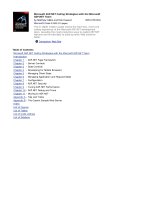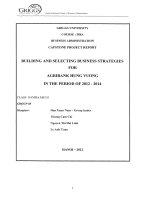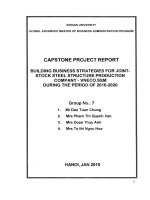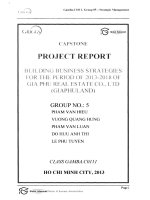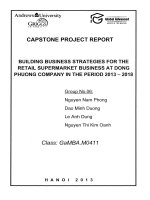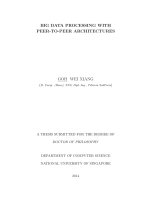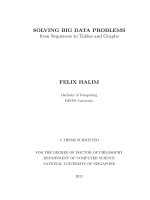Big Data MBA: Driving Business Strategies with Data Science
Bạn đang xem bản rút gọn của tài liệu. Xem và tải ngay bản đầy đủ của tài liệu tại đây (8.76 MB, 372 trang )
<span class='text_page_counter'>(1)</span><div class='page_container' data-page=1></div>
<span class='text_page_counter'>(2)</span><div class='page_container' data-page=2></div>
<span class='text_page_counter'>(3)</span><div class='page_container' data-page=3></div>
<span class='text_page_counter'>(4)</span><div class='page_container' data-page=4></div>
<span class='text_page_counter'>(5)</span><div class='page_container' data-page=5></div>
<span class='text_page_counter'>(6)</span><div class='page_container' data-page=6>
Chapter14:OrganizationalRamifications
ChiefDataMonetizationOfficer
Privacy,Trust,andDecisionGovernance
UnleashingOrganizationalCreativity
Summary
HomeworkAssignment
Notes
Chapter15:Stories
CustomerandEmployeeAnalytics
ProductandDeviceAnalytics
NetworkandOperationalAnalytics
CharacteristicsofaGoodBusinessStory
Summary
HomeworkAssignment
Notes
</div>
<span class='text_page_counter'>(7)</span><div class='page_container' data-page=7>
<b>ListofIllustrations</b>
Chapter1:TheBigDataBusinessMandate
Figure1.1BigDataBusinessModelMaturityIndex
Figure1.2Moderndata/analyticsenvironment
Chapter2:BigDataBusinessModelMaturityIndex
Figure2.1BigDataBusinessModelMaturityIndex
Figure2.2Crossingtheanalyticschasm
Figure2.3Packagingandsellingaudienceinsights
Figure2.4Optimizeinternalprocesses
Figure2.5Createnewmonetizationopportunities
Chapter3:TheBigDataStrategyDocument
Figure3.1Bigdatastrategydecompositionprocess
Figure3.2Bigdatastrategydocument
Figure3.3Chipotle's2012lettertotheshareholders
Figure3.4Chipotle's“increasesamestoresales”businessinitiative
Figure3.5Chipotlekeybusinessentitiesanddecisions
Figure3.6CompletedChipotlebigdatastrategydocument
Figure3.7BusinessvalueofpotentialChipotledatasources
Figure3.8ImplementationfeasibilityofpotentialChipotledatasources
Figure3.9Chipotleprioritizationofusecases
Figure3.10SanFranciscoGiantsbigdatastrategydocument
Figure3.11Chipotle'ssamestoresalesresults
Chapter4:TheImportanceoftheUserExperience
Figure4.1Originalsubscribere-mail
Figure4.2Improvedsubscribere-mail
Figure4.3Actionablesubscribere-mail
Figure4.4Apprecommendations
Figure4.5TraditionalBusinessIntelligencedashboard
Figure4.6Actionablestoremanagerdashboard
</div>
<span class='text_page_counter'>(8)</span><div class='page_container' data-page=8>
Figure4.9Localeventsusecase
Figure4.10Localweatherusecase
Figure4.11Financialadvisordashboard
Figure4.12Clientpersonalinformation
Figure4.13Clientfinancialinformation
Figure4.14Clientfinancialgoals
Figure4.15Financialcontributionsrecommendations
Figure4.16Spendanalysisandrecommendations
Figure4.17Assetallocationrecommendations
Figure4.18Otherinvestmentrecommendations
Chapter5:DifferencesBetweenBusinessIntelligenceandDataScience
Figure5.1SchmarzoTDWIkeynote,August2008
Figure5.2OaklandA'sversusNewYorkYankeescostperwin
Figure5.3BusinessIntelligenceversusdatascience
Figure5.4CRISP:CrossIndustryStandardProcessforDataMining
Figure5.5BusinessIntelligenceengagementprocess
Figure5.6TypicalBItoolgraphicoptions
Figure5.7Datascientistengagementprocess
Figure5.8Measuringgoodnessoffit
Figure5.9Dimensionalmodel(starschema)
Figure5.10UsingflatfilestoeliminateorreducejoinsonHadoop
Figure5.11Samplecustomeranalyticprofile
Figure5.12Improvecustomerretentionexample
Chapter6:DataScience101
Figure6.1Basictrendanalysis
Figure6.2Compoundtrendanalysis
Figure6.3Trendlineanalysis
Figure6.4Boxplotanalysis
Figure6.5Geographical(spatial)trendanalysis
Figure6.6Pairsplotanalysis
</div>
<span class='text_page_counter'>(9)</span><div class='page_container' data-page=9>
Figure6.8Clusteranalysis
Figure6.9Normalcurveequivalentanalysis
Figure6.10Normalcurveequivalentsellerpricinganalysisexample
Figure6.11Associationanalysis
Figure6.12Convertingassociationrulesintosegments
Figure6.13Graphanalysis
Figure6.14Textmininganalysis
Figure6.15Sentimentanalysis
Figure6.16Traversepatternanalysis
Figure6.17Decisiontreeclassifieranalysis
Figure6.18Cohortsanalysis
Chapter7:TheDataLake
Figure7.1Characteristicsofadatalake
Figure7.2Theanalyticsdilemma
Figure7.3Thedatalakelineofdemarcation
Figure7.4CreateaHadoop-baseddatalake
Figure7.5Createananalyticsandbox
Figure7.6MoveETLtothedatalake
Figure7.7HubandSpokeanalyticsarchitecture
Figure7.8Datascienceengagementprocess
Figure7.9Whatdoesthefuturehold?
Figure7.10EMCFederationBusinessDataLake
Chapter8:ThinkingLikeaDataScientist
Figure8.1FootLocker'skeybusinessinitiatives
Figure8.2ExamplesofFootLocker'sin-storemerchandising
Figure8.3FootLocker'sstoremanagerpersona
Figure8.4FootLocker'sstrategicnounsorkeybusinessentities
Figure8.5Thinkinglikeadatascientistdecompositionprocess
Figure8.6Recommendationsworksheettemplate
Figure8.7FootLocker'srecommendationsworksheet
</div>
<span class='text_page_counter'>(10)</span><div class='page_container' data-page=10>
Figure8.9Thinkinglikeadatascientistdecompositionprocess
Chapter9:“By”AnalysisTechnique
Figure9.1Identifyingmetricsthatmaybebetterpredictorsofperformance
Figure9.2NBAshootingeffectiveness
Figure9.3LeBronJames'sshootingeffectiveness
Chapter10:ScoreDevelopmentTechnique
Figure10.1FICOscoreconsiderations
Figure10.2FICOscoredecisionrange
Figure10.3Recommendationsworksheet
Figure10.4Updatedrecommendationsworksheet
Figure10.5Completedrecommendationsworksheet
Figure10.6PotentialFootLockercustomerscores
Figure10.7FootLockerrecommendationsworksheet
Figure10.8CLTVbasedonsales
Figure10.9MorepredictiveCLTVscore
Chapter11:MonetizationExercise
Figure11.1“Adayinthelife”customerpersona
Figure11.2Fitnesstrackerprioritization
Figure11.3Monetizationroadmap
Chapter12:MetamorphosisExercise
Figure12.1BigDataBusinessModelMaturityIndex
Figure12.2Patientactionableanalyticprofile
Chapter13:PowerofEnvisioning
Figure13.1BigDataVisionWorkshopprocessandtimeline
Figure13.2BigDataVisionWorkshopillustrativeanalytics
Figure13.3BigDataVisionWorkshopuserexperiencemock-up
Figure13.4PrioritizeHealthcareSystems'susecases
Figure13.5Prioritizationmatrixtemplate
Figure13.6Prioritizationmatrixprocess
Chapter14:OrganizationalRamifications
</div>
<span class='text_page_counter'>(11)</span><div class='page_container' data-page=11></div>
<span class='text_page_counter'>(12)</span><div class='page_container' data-page=12>
<b>ListofTables</b>
Chapter1:TheBigDataBusinessMandate
Table1.1ExploitingTechnologyInnovationtoCreateEconomic-Driven
BusinessOpportunities
Table1.2EvolutionoftheBusinessQuestions
Chapter2:BigDataBusinessModelMaturityIndex
Table2.1BigDataBusinessModelMaturityIndexSummary
Chapter3:TheBigDataStrategyDocument
Table3.1MappingChipotleUseCasestoAnalyticModels
Chapter5:DifferencesBetweenBusinessIntelligenceandDataScience
Table5.1BIAnalystVersusDataScientistCharacteristics
Chapter6:DataScience101
Table6.12014–2015TopNBARPMRankings
Table6.2CaseStudySummary
Chapter7:TheDataLake
Table7.1DataLakeDataTypes
Chapter8:ThinkingLikeaDataScientist
Table8.1EvolutionofFootLocker'sBusinessQuestions
Chapter9:“By”AnalysisTechnique
Table9.1LeBronJames'sShootingPercentages
Chapter10:ScoreDevelopmentTechnique
Table10.1PotentialScoresforOtherIndustries
Chapter11:MonetizationExercise
Table11.1PotentialFitnessTrackerRecommendations
Table11.2RecommendationDataRequirements
Table11.3RecommendationsValueVersusFeasibilityAssessment
Chapter12:MetamorphosisExercise
</div>
<span class='text_page_counter'>(13)</span><div class='page_container' data-page=13></div>
<span class='text_page_counter'>(14)</span><div class='page_container' data-page=14></div>
<span class='text_page_counter'>(15)</span><div class='page_container' data-page=15>
<b>OverviewoftheBookandTechnology</b>
Thedayswhenbusinessstakeholderscouldrelinquishcontrolofdataand
analyticstoITareover.Thebusinessstakeholdersmustbefrontandcenterin
championingandmonetizingtheorganization'sdatacollectionandanalysis
efforts.Businessleadersneedtounderstandwhereandhowtoleveragebigdata,
exploitingthecollisionofnewsourcesofcustomer,product,andoperationaldata
coupledwithdatasciencetooptimizekeybusinessprocesses,uncovernew
monetizationopportunities,andcreatenewsourcesofcompetitivedifferentiation.
Andwhileit'snotrealistictoconvertyourbusinessusersintodatascientists,it's
<i>criticalthatweteachthebusinessuserstothinklikedatascientistssotheycan</i>
collaboratewithITandthedatascientistsonusecaseidentification,requirements
definition,businessvaluation,andultimatelyanalyticsoperationalization.
Thisbookprovidesabusiness-hardenedframeworkwithsupportingmethodology
andhands-onexercisesthatnotonlywillhelpbusinessuserstoidentifywhere
andhowtoleveragebigdataforbusinessadvantagebutwillalsoprovide
</div>
<span class='text_page_counter'>(16)</span><div class='page_container' data-page=16>
<b>HowThisBookIsOrganized</b>
Thebookisorganizedintofoursections:
<b>PartI:BusinessPotentialofBigData.</b>PartIincludesChapters1through
4andsetsthebusiness-centricfoundationforthebook.HereiswhereI
introducetheBigDataBusinessModelMaturityIndexandframethebigdata
discussionaroundtheperspectivethat“organizationsdonotneedabigdata
strategyasmuchastheyneedabusinessstrategythatincorporatesbigdata.”
<b>PartII:DataScience.</b>PartIIincludesChapters5through7andcoversthe
principlebehinddatascience.Thesechaptersintroducesomedatascience
basicsandexplorethecomplementarynatureofBusinessIntelligenceanddata
scienceandhowthesetwodisciplinesarebothcomplementaryanddifferentin
theproblemsthattheyaddress.
<b>PartIII:DataScienceforBusinessStakeholders.</b>PartIIIincludes
Chapters8through12andseekstoteachthebusinessusersandbusiness
leadersto“thinklikeadatascientist.”Thispartintroducesamethodologyand
severalexercisestoreinforcethedatasciencethinkingandapproach.Ithasa
lotofhands-onwork.
</div>
<span class='text_page_counter'>(17)</span><div class='page_container' data-page=17></div>
<span class='text_page_counter'>(18)</span><div class='page_container' data-page=18></div>
<span class='text_page_counter'>(19)</span><div class='page_container' data-page=19>
<b>WhoShouldReadThisBook</b>
Thisbookistargetedtowardbusinessusersandbusinessmanagement.Iwrote
thisbooksothatIcoulduseitinteachingmyBigDataMBAclass,soincludedall
ofthehands-onexercisesandtemplatesthatmystudentswouldneedto
successfullyearntheirBigDataMBAgraduationcertificate.
<i>Ithinkfolkswouldbenefitbyalsoreadingmyfirstbook,BigData:</i>
</div>
<span class='text_page_counter'>(20)</span><div class='page_container' data-page=20>
<b>ToolsYouWillNeed</b>
</div>
<span class='text_page_counter'>(21)</span><div class='page_container' data-page=21>
<b>What'sontheWebsite</b>
Youcandownloadthe“ThinkingLikeaDataScientist”workbookfromthebook's
websiteatwww.wiley.com/go/bigdatamba.Andoh,theremightbeanothersurprise
</div>
<span class='text_page_counter'>(22)</span><div class='page_container' data-page=22>
<b>WhatThisMeansforYou</b>
AsstudentsfrommyclassatUSFhavetoldme,thismaterialallowsthemtotakea
problemorchallengeanduseawell-thought-outprocesstodrivecross-organizationalcollaborationtocomeupwithideastheycanturnintoactions
</div>
<span class='text_page_counter'>(23)</span><div class='page_container' data-page=23></div>
<span class='text_page_counter'>(24)</span><div class='page_container' data-page=24>
<b>PartI</b>
<b>BusinessPotentialofBigData</b>
Chapters1through4setthefoundationfordrivingbusinessstrategieswithdata
science.Inparticular,theBigDataBusinessModelMaturityIndexhighlightsthe
realmofwhat'spossiblefromabusinesspotentialperspectivebyprovidingaroad
mapthatmeasurestheeffectivenessofyourorganizationtoleveragedataand
analyticstopoweryourbusinessmodels.
<b>InThisPart</b>
Chapter1:TheBigDataBusinessMandate
Chapter2:BigDataBusinessModelMaturityIndex
Chapter3:TheBigDataStrategyDocument
</div>
<span class='text_page_counter'>(25)</span><div class='page_container' data-page=25></div>
<span class='text_page_counter'>(26)</span><div class='page_container' data-page=26>
<b>Chapter1</b>
<b>TheBigDataBusinessMandate</b>
<i>Havingtroublegettingyourseniormanagementteamtounderstandthe</i>
<i>businesspotentialofbigdata?Can'tgetyourmanagementleadershipto</i>
<i>considerbigdatatobesomethingotherthananITscienceexperiment?Are</i>
<i>yourline-of-businessleadersunwillingtocommitthemselvesto</i>
<i>understandinghowdataandanalyticscanpowertheirtopinitiatives?</i>
<i>Ifso,thenthis“BigDataSeniorExecutiveCarePackage”isforyou!</i>
<i>Andforalimitedtime,yougetanunlimitedlicensetosharethiscare</i>
<i>packagewithasmanyseniorexecutivesasyoudesire.Butyoumustact</i>
<i>NOW!Becomethelifeofthecompanypartieswithyourextensive</i>
<i>knowledgeofhownewcustomer,product,andoperationalinsightscan</i>
<i>guideyourorganization'svaluecreationprocesses.Andmaybe,justmaybe,</i>
<i>getapromotionintheprocess!!</i>
<b>NOTE</b>
</div>
<span class='text_page_counter'>(27)</span><div class='page_container' data-page=27>
<b>BigDataMBAIntroduction</b>
Thedayswhenbusinessusersandbusinessmanagementcanrelinquishcontrolof
dataandanalyticstoITareover,oratleastfororganizationsthatwanttosurvive
beyondtheimmediateterm.Thebigdatadiscussionnowneedstofocusonhow
organizationscancouplenewsourcesofcustomer,product,andoperationaldata
withadvancedanalytics(datascience)topowertheirkeybusinessprocessesand
<i>elevatetheirbusinessmodels.Organizationsneedtounderstandthattheydonot</i>
<i>needabigdatastrategyasmuchastheyneedabusinessstrategythat</i>
<i>incorporatesbigdata.</i>
<i>TheBigDataMBAchallengesthethinkingthatdataandanalyticsareancillaryor</i>
<i>a“bolton”tothebusiness;thatdataandanalyticsaresomeoneelse'sproblem.In</i>
agrowingnumberofleadingorganizations,dataandanalyticsarecriticalto
businesssuccessandlong-termsurvival.Businessleadersandbusinessusers
readingthisbookwilllearnwhytheymusttakeresponsibilityforidentifying
whereandhowtheycanapplydataandanalyticstotheirbusinesses—otherwise
theyputtheirbusinessesatriskofbeingmadeobsoletebymorenimble,data-drivencompetitors.
<i>TheBigDataMBAintroducesanddescribesconcepts,techniques,methodologies,</i>
<i><b>andhand-onexercisestoguideyouasyouseektoaddressthebigdatabusiness</b></i>
<i><b>mandate.Thebookprovideshands-onexercisesandhomeworkassignmentsto</b></i>
maketheseconceptsandtechniquescometolifeforyourorganization.Itprovides
recommendationsandactionsthatenableyourorganizationtostarttoday.Andin
<i>theprocess,BigDataMBAteachesyouto“thinklikeadatascientist.”</i>
</div>
<span class='text_page_counter'>(28)</span><div class='page_container' data-page=28>
<b>Figure1.1</b>BigDataBusinessModelMaturityIndex
TheBigDataBusinessModelMaturityIndexprovidesaroadmapforhow
organizationscanintegratedataandanalyticsintotheirbusinessmodels.TheBig
DataBusinessModelMaturityIndexiscomposedofthefollowingfivephases:
<b>Phase1:BusinessMonitoring.IntheBusinessMonitoringphase,</b>
organizationsareleveragingdatawarehousingandBusinessIntelligenceto
monitortheorganization'sperformance.
<b>Phase2:BusinessInsights.TheBusinessInsightsphaseisabout</b>
leveragingpredictiveanalyticstouncovercustomer,product,andoperational
insightsburiedinthegrowingwealthofinternalandexternaldatasources.In
thisphase,organizationsaggressivelyexpandtheirdataacquisitioneffortsby
couplingalloftheirdetailedtransactionalandoperationaldatawithinternal
datasuchasconsumercomments,e-mailconversations,andtechniciannotes,
aswellasexternalandpubliclyavailabledatasuchassocialmedia,weather,
traffic,economic,demographics,homevalues,andlocaleventsdata.
<b>Phase3:BusinessOptimization.IntheBusinessOptimizationphase,</b>
organizationsapplyprescriptiveanalyticstothecustomer,product,and
operationalinsightsuncoveredintheBusinessInsightsphasetodeliver
actionableinsightsorrecommendationstofrontlineemployees,business
managers,andchannelpartners,aswellascustomers.ThegoaloftheBusiness
Optimizationphaseistoenableemployees,partners,andcustomersto
optimizetheirkeydecisions.
<b>Phase4:DataMonetization.IntheDataMonetizationphase,</b>
organizationsleveragethecustomer,product,andoperationalinsightsto
createnewsourcesofrevenue.Thiscouldincludesellingdata—orinsights—
intonewmarkets(acellularphoneprovidersellingcustomerbehavioraldata
toadvertisers),integratinganalyticsintoproductsandservicestocreate
</div>
<span class='text_page_counter'>(29)</span><div class='page_container' data-page=29>
<b>Phase5:BusinessMetamorphosis.TheholygrailoftheBigData</b>
BusinessModelMaturityIndexiswhenanorganizationtransitionsits
businessmodelfromsellingproductstoselling“business-as-a-service.”Think
GEselling“thrust”insteadofjetengines.ThinkJohnDeereselling“farming
optimization”insteadoffarmingequipment.ThinkBoeingselling“airmiles”
insteadofairplanes.Andintheprocess,theseorganizationswillcreatea
platformenablingthird-partydeveloperstobuildandmarketsolutionsontop
oftheorganization'sbusiness-as-a-servicebusinessmodel.
Ultimately,bigdataonlymattersifithelpsorganizationsmakemoremoneyand
improveoperationaleffectiveness.Examplesincludeincreasingcustomer
acquisition,reducingcustomerchurn,reducingoperationalandmaintenance
costs,optimizingpricesandyield,reducingrisksanderrors,improving
compliance,improvingthecustomerexperience,andmore.
</div>
<span class='text_page_counter'>(30)</span><div class='page_container' data-page=30></div>
<span class='text_page_counter'>(31)</span><div class='page_container' data-page=31></div>
<span class='text_page_counter'>(32)</span><div class='page_container' data-page=32>
innovationslikeHadoopandSpark,therealdiscussionshouldbeaboutthe
economicimpactofbigdata.Newtechnologiesdon'tdisruptbusinessmodels;it's
whatorganizationsdowiththesenewtechnologiesthatdisruptsbusinessmodels
andenablesnewones.Let'sreviewanexampleofonesucheconomic-driven
businesstransformation:thesteamengine.
Thesteamengineenabledurbanization,industrialization,andtheconqueringof
newterritories.Itliterallyshrankdistanceandtimebyreducingthetimerequired
tomovepeopleandgoodsfromonesideofacontinenttotheother.Thesteam
engineenabledpeopletoleavelow-payingagriculturaljobsandmoveintocities
forhigher-payingmanufacturingandclericaljobsthatledtoahigherstandardof
living.
Forexample,citiessuchasLondonshotupintermsofpopulation.In1801,before
theadventofGeorgeStephenson'sRocketsteamengine,Londonhad1.1million
residents.Aftertheinvention,thepopulationofLondonmorethandoubledto2.7
millionresidentsby1851.Londontransformedthenucleusofsocietyfromsmall
tight-knitcommunitieswheretextileproductionandagriculturewereprevalent
intobigcitieswithavarietyofjobs.Thesteamlocomotiveprovidedquicker
transportationandmorejobs,whichinturnbroughtmorepeopleintothecities
anddrasticallychangedthejobmarket.By1861,only2.4percentofLondon's
populationwasemployedinagriculture,while49.4percentwereinthe
manufacturingortransportationbusiness.Thesteamlocomotivewasamajor
turningpointinhistoryasittransformedsocietyfromlargelyruraland
agriculturalintourbanandindustrial.2
</div>
<span class='text_page_counter'>(33)</span><div class='page_container' data-page=33></div>
<span class='text_page_counter'>(34)</span><div class='page_container' data-page=34></div>
<span class='text_page_counter'>(35)</span><div class='page_container' data-page=35></div>
<span class='text_page_counter'>(36)</span><div class='page_container' data-page=36>
warehousing)andanalytics(datascience)environmentsdifferently.Thesetwo
environmentshaveverydifferentcharacteristicsandservedifferentpurposes.The
datalakecanmakebothoftheBIanddatascienceenvironmentsmoreagileand
moreproductive(Figure1.2).
<b>Figure1.2</b>Moderndata/analyticsenvironment
<b>CROSS-REFERENCE</b>
Chapter7(”TheDataLake“)introducestheconceptofadatalakeandtherole
thedatalakeplaysinsupportingyourexistingdatawarehouseandBusiness
Intelligenceinvestmentswhileprovidingthefoundationforyourdatascience
environment.Chapter7discusseshowthedatalakecanun-cuffyourdata
scientistsfromthedatawarehousetouncoverthosevariablesandmetricsthat
mightbebetterpredictorsofbusinessperformance.Italsodiscusseshowthe
datalakecanfreeupexpensivedatawarehouseresources,especiallythose
resourcesassociatedwithExtract,Transform,andLoad(ETL)dataprocesses.
<b>Don'tThink“WhatHappened,”Think“WhatWillHappen”</b>
Businessusershavebeentrainedtocontemplatebusinessquestionsthatmonitor
thecurrentstateofthebusinessandtofocusonretrospectivereportingonwhat
happened.BusinessusershavebecomeconditionedbytheirBIanddata
warehouseenvironmentstoonlyconsiderquestionsthatreportoncurrent
businessperformance,suchas“HowmanywidgetsdidIselllastmonth?”and
“Whatweremygrosssaleslastquarter?”
</div>
<span class='text_page_counter'>(37)</span><div class='page_container' data-page=37></div>
<span class='text_page_counter'>(38)</span><div class='page_container' data-page=38>
Unfortunately,thattypeofthinkinghasledtosiloeddatafiefdoms,siloed
decisions,andanun-empoweredandfrustratedbusinessteam.Organizations
needtothinkdifferentlyabouthowtheyempoweralloftheiremployees.
Organizationsneedtofindawaytopromoteandnurturecreativethinkingand
groundbreakingideasacrossalllevelsoftheorganization.Thereisnoedictthat
statesthatthebestideasonlycomefromseniormanagement.
Thekeytobigdatasuccessisempoweringcross-functionalcollaborationand
exploratorythinkingtochallengelong-heldorganizationalrulesofthumb,
heuristics,and“gut”decisionmaking.Thebusinessneedsanapproachthatis
inclusiveofallthekeystakeholders—IT,businessusers,businessmanagement,
channelpartners,andultimatelycustomers.Thebusinesspotentialofbigdatais
onlylimitedbythecreativethinkingoftheorganization.
<b>CROSS-REFERENCE</b>
Chapter13(“PowerofEnvisioning”)discusseshowtheBIanddatascience
teamscancollaboratetobrainstorm,test,andrefinenewvariablesthatmight
bebetterpredictorsofbusinessperformance.Wewillintroduceseveral
techniquesandconceptsthatcanbeusedtodrivecollaborationbetweenthe
businessandITstakeholdersandultimatelyhelpyourdatascienceteam
uncovernewcustomer,product,andoperationalinsightsthatleadtobetter
businessperformance.Chapter14(“OrganizationalRamifications”)
</div>
<span class='text_page_counter'>(39)</span><div class='page_container' data-page=39></div>
<span class='text_page_counter'>(40)</span><div class='page_container' data-page=40></div>
<span class='text_page_counter'>(41)</span><div class='page_container' data-page=41>
<b>HomeworkAssignment</b>
Usethefollowingexercisestoapplywhatyoulearnedinthischapter.
<b>Exercise#1:Identifyakeybusinessinitiativeforyourorganization,</b>
somethingthebusinessistryingtoaccomplishoverthenext9to12months.It
mightbesomethinglikeimprovecustomerretention,optimizecustomer
acquisition,reducecustomerchurn,optimizepredictivemaintenance,reduce
revenuetheft,andsoon.
<b>Exercise#2:Brainstormandwritedownwhat(1)customer,(2)product,and</b>
(3)operationalinsightsyourorganizationwouldliketouncoverinorderto
supportthetargetedbusinessinitiative.Startbycapturingthedifferenttypes
ofdescriptive,predictive,andprescriptivequestionsyou'dliketoanswerabout
thetargetedbusinessinitiative.Tip:Don'tworryaboutwhetherornotyou
havethedatasourcesyouneedtoderivetheinsightsyouwant(yet).
<b>Exercise#3:Brainstormandwritedowndatasourcesthatmightbeusefulin</b>
uncoveringthosekeyinsights.Lookbothinternallyandexternallyfor
</div>
<span class='text_page_counter'>(42)</span><div class='page_container' data-page=42>
<b>Notes</b>
1<sub>Hopkins,Brian,FatemehKhatibloowithKyleMcNabb,JamesStaten,Andras</sub>
Cser,HolgerKisker,Ph.D.,LeslieOwens,JenniferBelissent,Ph.D.,Abigail
Komlenic,“ResetOnBigData:EmbraceBigDatatoEngageCustomersat
Scale,”ForresterResearch,2014.
</div>
<span class='text_page_counter'>(43)</span><div class='page_container' data-page=43></div>
<span class='text_page_counter'>(44)</span><div class='page_container' data-page=44>
<b>Chapter2</b>
<b>BigDataBusinessModelMaturityIndex</b>
Organizationsdonotunderstandhowfarbigdatacantakethemfromabusiness
transformationperspective.Organizationsdon'thaveawayofunderstanding
whattheultimatebigdataendstatewouldorcouldlooklikeoranswering
questionssuchas:
WhereandhowshouldIstartmybigdatajourney?
HowcanIcreatenewrevenueormonetizationopportunities?
HowdoIcomparetootherswithrespecttomyorganization'sadoptionofbig
dataasabusinessenabler?
HowfarcanIpushbigdatatopower—eventransform—mybusinessmodels?
<i><b>Tohelpaddressthesetypesofquestions,I'vecreatedtheBigDataBusiness</b></i>
<i><b>ModelMaturityIndex.Notonlycanorganizationscanusethisindexto</b></i>
understandwheretheysitwithrespecttootherorganizationsinexploitingbig
dataandadvancedanalyticstopowertheirbusinessmodels,buttheindex
providesaroadmaptohelporganizationsacceleratetheintegrationofdataand
analyticsintotheirbusinessmodels.
</div>
<span class='text_page_counter'>(45)</span><div class='page_container' data-page=45>
<b>Chapter2Objectives</b>
IntroducetheBigDataBusinessModelMaturityIndexasaframeworkfor
organizationstomeasurehoweffectivetheyareatleveragingdataand
analyticstopowertheirbusinessmodels
Discusstheobjectivesandcharacteristicsofeachofthefivephasesofthe
BigDataBusinessModelMaturityIndex:BusinessMonitoring,Business
Insights,BusinessOptimization,DataMonetization,andBusiness
Metamorphosis
<i><b>Discusshowtheeconomicsofbigdataandthefourbigdatavalue</b></i>
<i><b>driverscanenableorganizationstocrosstheanalyticschasmand</b></i>
advancepasttheBusinessMonitoringphaseintotheBusinessInsights
andBusinessOptimizationphases
</div>
<span class='text_page_counter'>(46)</span><div class='page_container' data-page=46>
<b>IntroducingtheBigDataBusinessModelMaturity</b>
<b>Index</b>
Organizationsaremovingatdifferentpaceswithrespecttowhereandhowthey
areadoptingbigdataandadvancedanalyticstocreatebusinessvalue.Some
organizationsaremovingverycautiously,astheyareunclearastowhereandhow
tostartandwhichofthebevyofnewtechnologyinnovationstheyneedtodeploy
inordertostarttheirbigdatajourneys.Othersaremovingatamoreaggressive
pacebyacquiringandassemblingabigdatatechnologyfoundationbuiltonmany
newbigdatatechnologiessuchasHadoop,Spark,MapReduce,YARN,Mahout,
Hive,HBase,andmore.
However,aselectfewarelookingbeyondjustthetechnologytoidentifywhereand
howtheyshouldbeintegratingbigdataintotheirexistingbusinessprocesses.
Theseorganizationsareaggressivelylookingtoidentifyandexploitopportunities
tooptimizekeybusinessprocesses.Andtheseorganizationsareseekingnew
monetizationopportunities;thatis,seekingoutbusinessopportunitieswherethey
can
Packageandselltheiranalyticinsightstoothers
Integrateadvancedanalyticsintotheirproductsandservicestocreate
“intelligent”products
Createentirelynewproductsandservicesthathelpthementernewmarkets
andtargetnewcustomers
Thesearethefolkswhorealizethattheydon'tneedabigdatastrategyasmuchas
theyneedabusinessstrategythatincorporatesbigdata.Andwhenorganizations
“flipthatbyte”onthefocusoftheirbigdatainitiatives,thebusinesspotentialis
almostboundless.
OrganizationscanusetheBigDataBusinessModelMaturityIndexasa
</div>
<span class='text_page_counter'>(47)</span><div class='page_container' data-page=47>
<b>Figure2.1</b>BigDataBusinessModelMaturityIndex
OrganizationstendtofindthemselvesinoneoffivephasesontheBigData
BusinessModelMaturityIndex:
<b>Phase1:BusinessMonitoring.IntheBusinessMonitoringphase,</b>
organizationsareapplyingdatawarehousingandBusinessIntelligence
techniquesandtoolstomonitortheorganization'sbusinessperformance(also
calledBusinessPerformanceManagement).
<b>Phase2:BusinessInsights.IntheBusinessInsightsphase,organizations</b>
<i>aggressivelyexpandtheirdataassetsbyamassingalloftheirdetailed</i>
transactionalandoperationaldataandcouplingthattransactionaland
operationaldatawithnewsourcesofinternaldata(e.g.,consumercomments,
e-mailconversations,techniciannotes)andexternaldata(e.g.,socialmedia,
weather,traffic,economic,data.gov)sources.OrganizationsintheBusiness
Insightsphasethenusepredictiveanalyticstouncovercustomer,product,and
operationalinsightsburiedinandacrossthesedatasources.
<b>Phase3:BusinessOptimization.IntheBusinessOptimizationphase,</b>
organizationsbuildonthecustomer,product,andoperationalinsights
uncoveredintheBusinessInsightsphasebyapplyingprescriptiveanalyticsto
optimizekeybusinessprocesses.OrganizationsintheBusinessOptimization
phasepushtheanalyticresults(e.g.,recommendations,scores,rules)to
frontlineemployeesandbusinessmanagerstohelpthemoptimizethetargeted
businessprocessthroughimproveddecisionmaking.TheBusiness
Optimizationphasealsoprovidesopportunitiesfororganizationstopush
analyticinsightstotheircustomersinordertoinfluencecustomerbehaviors.
AnexampleoftheBusinessOptimizationphaseisaretailerthatdelivers
analytic-basedmerchandisingrecommendationstothestoremanagersto
optimizemerchandisemarkdownsbasedonpurchasepatterns,inventory,
weatherconditions,holidays,consumercomments,andsocialmediapostings.
<b>Phase4:DataMonetization.TheDataMonetizationphaseiswhere</b>
</div>
<span class='text_page_counter'>(48)</span><div class='page_container' data-page=48></div>
<span class='text_page_counter'>(49)</span><div class='page_container' data-page=49></div>
<span class='text_page_counter'>(50)</span><div class='page_container' data-page=50></div>
<span class='text_page_counter'>(51)</span><div class='page_container' data-page=51></div>
<span class='text_page_counter'>(52)</span><div class='page_container' data-page=52>
theaveragecampaignperformanceincertainmarketsoncertaindaysof
theweek
Customersthatarereactingtwotothreestandarddeviationsoutsidethe
normintheirpurchasepatternsforcertainproductcategoriesincertain
weatherconditions
Supplierswhosecomponentsareoperatingoutsidetheupperorlower
limitsofacontrolchartinextremecoldweathersituations
<b>CROSS-REFERENCE</b>
Forthepredictiveanalyticstobeeffective,organizationsneedtobuild
detailedanalyticprofilesforeachindividualbusinessentity—customers,
patients,students,windturbines,jetengines,ATMs,etc.Thecreationand
roleofanalyticprofilesisatopiccoveredinChapter5,“DifferencesBetween
BusinessIntelligenceandDataScience.”
<i><b>BusinessInsightsPhaseChallenge</b></i>
TheBusinessInsightsphaseisthemostdifficultstageoftheBigDataBusiness
ModelMaturityIndexbecauseitrequiresorganizationsto“thinkdifferently”
abouthowtheyapproachdataandanalytics.Therules,techniques,and
approachesthatworkedintheBusinessIntelligenceanddatawarehouseworlds
donotnecessaryapplytotheworldofbigdata.Thisistrulythe“crossingthe
analyticschasm”moment(seeFigure2.2).
<b>Figure2.2</b>Crossingtheanalyticschasm
</div>
<span class='text_page_counter'>(53)</span><div class='page_container' data-page=53></div>
<span class='text_page_counter'>(54)</span><div class='page_container' data-page=54></div>
<span class='text_page_counter'>(55)</span><div class='page_container' data-page=55>
<b>Figure2.3</b>Packagingandsellingaudienceinsights
Integratinganalyticinsightsdirectlyintoanorganization'sproductsand
servicestocreate“intelligent”productsorservices,suchas:
Carsthatlearnacustomer'sdrivingpatternsandbehaviorsandadjust
drivercontrols,seats,mirrors,brakepedals,suspension,steering,
dashboarddisplays,etc.tomatchthecustomer'sdrivingstyle
TelevisionsandDVRsthatlearnwhattypesofshowsandmoviesa
customerlikesandsearchacrossthedifferentcableandInternetchannels
tofindandautomaticallyrecordsimilarshowsforthatcustomer
Ovensthatlearnhowacustomerlikescertainfoodspreparedandcooks
theminthatmannerautomaticallyandalsoincluderecommendationsfor
otherfoodsandrecipesthat“otherslikeyou”enjoy
Jetenginesthatcaningestweather,elevation,windspeed,andother
environmentaldatatomakeadjustmentstobladeangles,tilt,yaw,and
rotationspeedstominimizefuelconsumptionduringflight
Repackaginginsightstocreateentirelynewproductsandservicesthathelp
organizationstoenternewmarketsandtargetnewcustomersoraudiences.
Forexample,organizationscancapture,analyze,andpackagecustomer,
product,andoperationalinsightsacrosstheoverallmarketinordertohelp
channelpartnerstomoreeffectivelymarketandselltotheircustomers,such
as:
Onlinedigitalmarketplaces(Yahoo,Google,eBay,Facebook)could
leveragegeneralmarkettrendsandothermerchantperformancedatato
providerecommendationstosmallmerchantsoninventory,ordering,
merchandising,marketing,andpricing.
</div>
<span class='text_page_counter'>(56)</span><div class='page_container' data-page=56></div>
<span class='text_page_counter'>(57)</span><div class='page_container' data-page=57>
patterns,localweather,localwaterquality,andlocalenvironmentalconditions
suchaslocalwaterconservationeffortsandenergycosts
Retailersmovingintothe“ShoppingOptimization”businessbyrecommending
specificproductsgivencustomers'currentbuyingpatternsascomparedwith
otherslikethem,includingrecommendationsforproductsthattheymaynot
evensell(think“Miracleon43rdStreet”)
Airlinesmovingintothe“TravelDelight”businessofnotonlyoffering
</div>
<span class='text_page_counter'>(58)</span><div class='page_container' data-page=58>
<b>BigDataBusinessModelMaturityIndexLessons</b>
<b>Learned</b>
Therearesomeinterestinglessonsthatorganizationswilldiscoverasthey
progressthroughthephasesoftheBigDataBusinessModelMaturityIndex.
Understandingtheselessonsaheadoftimeshouldhelpprepareorganizationsfor
theirbigdatajourney.
<b>Lesson1:FocusInitialBigDataEffortsInternally</b>
ThefirstthreephasesoftheBigDataBusinessModelMaturityIndexseekto
extractmorefinancialorbusinessvalueoutoftheorganization'sinternal
processesorbusinessinitiatives.Thefirstthreephasesdrivebusinessvalueanda
ReturnonInvestment(ROI)byseekingtointegratenewsourcesofcustomer,
product,operational,andmarketdatawithadvancedanalyticstoimprovethe
decisionsthataremadeaspartoftheorganization'skeyinternalprocessand
businessinitiatives(seeFigure2.4).
<b>Figure2.4</b>Optimizeinternalprocesses
<i><b>Theinternalprocessoptimizationeffortsstartbyseekingtoleveragethe</b></i>
organization'sBusinessIntelligenceanddatawarehouseassets.Thisincludes
buildingonthedatawarehouse'sdatasources,dataextractionandenrichment
algorithms,dimensions,metrics,keyperformanceindicators,reports,and
</div>
<span class='text_page_counter'>(59)</span><div class='page_container' data-page=59>
<b>TheFourBigDataValueDrivers</b>
1. Accesstoalltheorganization'sdetailedtransactionalandoperationaldata
atthelowestlevelofgranularity(attheindividualcustomer,machine,or
devicelevel).
2. Integrationofunstructureddatafrombothinternal(consumercomments,
e-mailthreads,techniciannotes)andexternalsources(socialmedia,
mobile,publiclyavailable)withthedetailedtransactionalandoperational
datatoprovidenewmetricsandnewdimensionsagainstwhichto
optimizekeybusinessprocesses.
3. Leveragereal-time(orright-time)dataanalysistoacceleratethe
organization'sabilitytoidentifyandactoncustomer,product,andmarket
opportunitiesinatimeliermanner.
4. Applypredictiveanalyticsanddataminingtouncovercustomer,product,
andoperationalinsightsorareasof“unusualness”buriedinthemassive
volumesofdetailedstructuredandunstructureddatathatareworthyof
furtherbusinessinvestigation.
Organizationsmustleveragethesefourbigdatavaluedriverstocrosstheanalytics
chasmbyuncoveringnewcustomer,product,andoperationalinsightsthatcanbe
usedtooptimizekeybusinessprocesses—whetherdeliveringactionable
recommendationstofrontlineemployeesandbusinessmanagersordelivering
“NextBestOffer”orrecommendationstodelightcustomersandbusiness
partners.
<b>Lesson2:LeverageInsightstoCreateNewMonetization</b>
<b>Opportunities</b>
ThelasttwophasesoftheBigDataBusinessModelMaturityIndexarefocusedon
externalmarketopportunities;opportunitiestocreatenewmonetizationor
</div>
<span class='text_page_counter'>(60)</span><div class='page_container' data-page=60>
<b>Figure2.5</b>Createnewmonetizationopportunities
Thisisthepartofthebigdatajourneythatcatchesmostorganizations'attention:
theopportunitytoleveragetheinsightsgatheredthroughtheoptimizationoftheir
keybusinessprocessestocreatenewrevenueormonetizationopportunities.
Organizationsareeagertoleveragenewcorporateassets—data,analytics,and
businessinsights—inordertocreatenewsourcesofrevenue.Thisisthe“4Ms”
phaseoftheBigDataBusinessModelMaturityIndexwhereorganizationsfocus
<i>onleveragingdataandanalyticstocreatenewopportunitiesto“MakeMeMore</i>
<i>Money!”</i>
<b>Lesson3:PreparingforOrganizationalTransformation</b>
Tofullyexploitthebigdataopportunity,subtleorganizationalandcultural
changeswillbenecessaryfortheorganizationtoadvancealongthematurity
index.Iforganizationsareseriousaboutintegratingdataandanalyticsintotheir
businessmodels,thenthreeorganizationalorculturaltransformationswillneed
totakeplace:
<b>1.TreatDataasanAsset.Organizationsmuststarttotreatdataasanasset</b>
tobenurturedandgrown,notacosttobeminimized.Organizationsmust
developaninsatiableappetiteformoreandmoredata—eveniftheyare
unclearastohowtheywillusethatdata.Thisisasignificantculturalchange
fromthedatawarehousedayswherewetreateddataasacosttobeminimized.
<b>2.LegallyProtectYourAnalyticsIntellectualProperty.Organizations</b>
mustputintoplaceformalprocessesandprocedurestocapture,track,refine,
andevenlegallyprotecttheiranalyticassets(e.g.,analyticmodels,data
enrichmentalgorithms,andanalyticresultssuchasscores,recommendations,
andassociationrules)askeyorganizationalintellectualproperty.Whilethe
underlyingtechnologiesmaychangeovertime,theresultingdataandanalytic
</div>
<span class='text_page_counter'>(61)</span><div class='page_container' data-page=61>
<b>3.GetComfortableUsingDatatoGuideDecisions.Business</b>
managementandbusinessusersmustgainconfidenceinusingdataand
analyticstoguidetheirdecisionmaking.Organizationsmustgetcomfortable
withmakingbusinessdecisionsbasedonwhatthedataandtheanalyticstell
themversusdefaultingtothe“HighestPaidPerson'sOpinion”(HIPPO).The
organization'sinvestmentsindata,analytics,people,processes,and
technologywillbefornaughtiftheorganizationisn'tpreparedtomake
decisionsbasedonwhatthedataandtheanalyticstellthem.Withthatsaid,
it'simportantthattheanalyticinsightsarepositionedas“recommendations”
thatbusinessusersandbusinessmanagementcanaccept,reject,ormodify.In
thatway,organizationscanleverageanalyticstoestablishorganizational
</div>
<span class='text_page_counter'>(62)</span><div class='page_container' data-page=62></div>
<span class='text_page_counter'>(63)</span><div class='page_container' data-page=63>
throughimproveddecisionmaking(orimprovedoperationaleffectivenessfor
non-profitorganizations).Bigdataholdsthepotentialtobothoptimizekey
businessprocessesandcreatenewmonetizationorrevenueopportunities.
Insummary:
TheBigDataBusinessModelMaturityIndexprovidesaframeworkfor
organizationstomeasurehoweffectivetheyareatleveragingdataand
analyticstopowertheirbusinessmodels.
ThefivephasesoftheBigDataBusinessModelMaturityIndexareBusiness
Monitoring,BusinessInsights,BusinessOptimization,DataMonetization,and
BusinessMetamorphosis.
Theeconomicsofbigdataandthefourbigdatavaluedriverscanenable
organizationstocrosstheanalyticschasm.
</div>
<span class='text_page_counter'>(64)</span><div class='page_container' data-page=64>
<b>HomeworkAssignment</b>
Usethefollowingexercisestoapplyandreinforcetheinformationpresentedin
thischapter:
<b>Exercise#1:Listtwoorthreeofyourorganization'skeybusinessprocesses.</b>
Thatis,writedowntwoorthreebusinessprocessesthatuniquelydifferentiate
yourorganizationfromyourcompetition.
<b>Exercise#2:Listthefourbigdatavaluedriversthatareenabledbythe</b>
economicsofbigdataanddescribehoweachmightimpactoneofyour
organization'skeybusinessprocessesidentifiedinExercise#1.
<b>Exercise#3:FortheselectedkeybusinessprocessesidentifiedinExercise</b>
#1,describehoweachkeybusinessprocessmightbeimprovedasittransitions
alongthefivephasesoftheBigDataBusinessModelMaturityIndex.Identify
thecustomer,product,andoperationalramificationsthateachofthefive
phasesmighthaveontheselectedkeybusinessprocess.
<b>Exercise#4:Listtheculturalchangesthatyourorganizationmustaddressif</b>
</div>
<span class='text_page_counter'>(65)</span><div class='page_container' data-page=65></div>
<span class='text_page_counter'>(66)</span><div class='page_container' data-page=66>
<b>Chapter3</b>
<b>TheBigDataStrategyDocument</b>
Oneofthebiggestchallengesorganizationsfacewithrespecttobigdatais
<i><b>identifyingwhereandhowtostart.Thebigdatastrategydocument,detailed</b></i>
inthischapter,providesaframeworkforlinkinganorganization'sbusiness
strategyandsupportingbusinessinitiativestotheorganization'sbigdataefforts.
Thebigdatastrategydocumentguidestheorganizationthroughtheprocessof
breakingdownitsbusinessstrategyandbusinessinitiativesintopotentialbigdata
businessusecasesandthesupportingdataandanalyticrequirements.
<b>NOTE</b>
<i>ThebigdatastrategydocumentfirstappearedinmybookBigData:</i>
<i>UnderstandingHowDataPowersBigBusiness.Sincethenandcourtesyof</i>
severalclientengagements,significantimprovementshavebeenmadetohelp
userstouncoverbigdatausecases.Inparticular,theprocesshasbeen
enhancedtoclarifythebusinessvalueandimplementationfeasibility
assessmentsofthedifferentdatasourcesandusecaseprioritization(see
Figure3.1).
</div>
<span class='text_page_counter'>(67)</span><div class='page_container' data-page=67>
<b>Chapter3Objectives</b>
Establishcommonterminologyforbigdata.
Examinetheconceptofabusinessinitiativeandprovidesomeexamplesof
wheretofindthesebusinessinitiatives.
Introducethebigdatastrategydocumentasaframeworkforhelping
organizationstoidentifytheusecasesthatguidewhereandhowtheycan
starttheirbigdatajourneys.
Provideahands-onexampleofthebigdatastrategydocumentinaction
usingChipotle,achainoforganicMexicanfoodrestaurants(andoneof
myfavoriteplacestoeat!).
Introduceworksheetstohelporganizationstodeterminethebusiness
valueandimplementationfeasibilityofthedatasourcesthatcomeoutof
thebigdatastrategydocumentprocess.
<i><b>Introducetheprioritizationmatrixasatoolthatcandrivebusiness</b></i>
andITalignmentaroundprioritizingtheusecasesbasedonbusinessvalue
andimplementationfeasibilityovera9-to12-monthwindow.
</div>
<span class='text_page_counter'>(68)</span><div class='page_container' data-page=68>
<b>EstablishingCommonBusinessTerminology</b>
Beforewelaunchintothebigdatastrategydocumentdiscussion,weneedto
defineafewcriticaltermstoensurethatweareusingconsistentterminology
throughoutthechapterandthebook:
<i><b>CorporateMission.Whytheorganizationexists;defineswhatan</b></i>
organizationisandtheorganization'sreasonforbeing.Forexample,TheWalt
DisneyCompany'scorporatemissionis“tobeoneoftheworld'sleading
producersandprovidersofentertainmentandinformation.”1
<i><b>BusinessStrategy.Howtheorganizationisgoingtoachieveitsmissionover</b></i>
thenexttwotothreeyears.
<i><b>StrategicBusinessInitiatives.Whattheorganizationplanstodoto</b></i>
achieveitsbusinessstrategyoverthenext9to12months;usuallyincludes
businessobjectives,financialtargets,metrics,andtimeframes.
<b>BusinessEntities.Thephysicalobjectsorentities(e.g.,customers,patients,</b>
students,doctors,windturbines,trucks)aroundwhichthebusinessinitiative
willtrytounderstand,predict,andinfluencebehaviorsandperformance
<i><b>(sometimesreferredtoasthestrategicnounsofthebusiness).</b></i>
<b>BusinessStakeholders.Thosebusinessfunctions(sales,marketing,</b>
finance,storeoperations,logistics,andsoon)thatimpactorareimpactedby
thestrategicbusinessinitiative.
<b>BusinessDecisions.Thedecisionsthatthebusinessstakeholdersneedto</b>
makeinsupportofthestrategicbusinessinitiative.
<i><b>BigDataUseCases.Theanalyticusecases(decisionsandcorresponding</b></i>
actions)thatsupportthestrategicbusinessinitiative.
<b>Data.Thestructuredandunstructureddatasources,bothinternaland</b>
</div>
<span class='text_page_counter'>(69)</span><div class='page_container' data-page=69>
<b>IntroducingtheBigDataStrategyDocument</b>
Thebigdatastrategydocumenthelpsorganizationsaddressthechallengeof
identifyingwhereandhowtostarttheirbigdatajourneys.Thebigdatastrategy
documentusesasingle-pageformatthatanyorganizationcanuse(profitornon-profit)thatlinksanorganization'sbigdataeffortstoitsbusinessstrategyandkey
businessinitiatives.Thebigdatastrategydocumentiseffectiveforthefollowing
reasons:
It'sconcise.Itfitsonasinglepagesothatanyoneintheorganizationcan
quicklyreviewittoensureheorsheisworkingonthetoppriorityitems.
It'sclear.Itclearlydefineswhattheorganizationneedstodoinorderto
achievetheorganization'skeybusinessinitiatives.
It'sbusinessrelevant.Itstartsbyfocusingonthebusinessstrategyand
supportinginitiativesbeforeitdivesintothedataandtechnology
requirements.
Thebigdatastrategydocumentiscomposedofthefollowingsections(seeFigure
3.2):
Businessstrategy
Keybusinessinitiatives
Keybusinessentities
Keydecisions
</div>
<span class='text_page_counter'>(70)</span><div class='page_container' data-page=70>
<b>Figure3.2</b>Bigdatastrategydocument
Therestofthechapterwilldetaileachofthesesectionsandprovideguidelinesfor
howtheorganizationcantriagetheorganization'sbusinessstrategyintothe
financialdrivers(orusecases)onwhichtheorganizationcanfocusitsbigdata
efforts.WewilluseacasestudyaroundChipotleMexicanGrillstoreinforcethe
triageandanalysisprocess.
<b>IdentifyingtheOrganization'sKeyBusinessInitiatives</b>
Thestartingpointforthebigdatastrategydocumentprocessistoidentifythe
organization'sbusinessinitiativesoverthenext9to12months.Thatis,whatis
thebusinesstryingtoaccomplishoverthenext9to12months?This9-to12-monthtimeframeiscritical,asit
Focusestheorganization'sbigdataeffortsonsomethingthatisofimmediate
valueandrelevancetothebusiness
Createsasenseofurgencyfortheorganizationtomovequicklyanddiligently
Givesthebigdataprojectamorerealisticchanceofdeliveringapositive
ReturnonInvestment(ROI)andafinancialpaybackin12monthsorless
Abusinessinitiativesupportsthebusinessstrategyandhasthefollowing
characteristics:
Criticaltoimmediate-termbusinessand/orfinancialperformance(usually9-to12-monthtimeframe)
</div>
<span class='text_page_counter'>(71)</span><div class='page_container' data-page=71></div>
<span class='text_page_counter'>(72)</span><div class='page_container' data-page=72>
<b>Figure3.3</b>Chipotle's2012lettertotheshareholders
FromthePresident'sLetter,wecanidentifyatleastfourkeybusinessinitiatives
forthecomingyear:
Improveemployee(talent)acquisition,maturation,andretention(whichis
especiallyimportantforanorganizationwhere90percentofitsmanagement
hascomeupthroughtheranksofthestore).
Continuedouble-digitrevenuegrowth(up20.3percentin2012)byopening
newstores(opened183over100in2012).
Increasesamestoresalesgrowth(7.1percentgrowthin2012).
ImprovemarketingeffectivenessonbuildingtheChipotlebrandandengaging
withcustomersinwaysthatcreatestronger,deeperbonds.
Whileanyfourofthesebusinessinitiativesareripeforthebigdatastrategy
document,fortheremainderofthisexercise,we'llfocusonthe“increasesame
storesales”businessinitiativebecauseincreasingsalesofabusinessentityor
outletisrelevantacrossanumberofdifferentindustries(i.e.,hospitality,gaming,
banking,insurance,retail,highereducation,healthcareproviders).
<b>IdentifyKeyBusinessEntitiesandKeyDecisions</b>
</div>
<span class='text_page_counter'>(73)</span><div class='page_container' data-page=73>
<b>NOTE</b>
Itisaroundthesebusinessentitiesthatwearegoingtowanttocapturethe
behaviors,tendencies,patterns,trends,preferences,etc.attheindividual
entitylevel.Forexample,acreditcardcompanywouldwanttocaptureBill
Schmarzo'sspecifictravelandbuyingpatternsandtendenciesinorderto
betterdetectfraudandimprovemerchantmarketingoffers.
Figure3.4showsthetemplatethatwearegoingtousetosupportthebigdata
strategydocumentprocess.Wehavealreadycapturedourtargeted“increasesame
storesales”businessinitiative.
<b>Figure3.4</b>Chipotle's“increasesamestoresales”businessinitiative
Takeamomenttowritedownwhatyouthinkmightbethekeybusinessentitiesor
strategicnounsforthe“increasesamestoresales”businessinitiative:
HerearethreebusinessentitiesthatIcameupwith:
Stores
</div>
<span class='text_page_counter'>(74)</span><div class='page_container' data-page=74></div>
<span class='text_page_counter'>(75)</span><div class='page_container' data-page=75></div>
<span class='text_page_counter'>(76)</span><div class='page_container' data-page=76>
Businessentity:Localevents
Decision:
Decision:
Businessentity:Localcompetitors
Decision:
Decision:
<b>NOTE</b>
Someofthedecisionswillbeverysimilar.That'sgoodbecauseitallowsthe
organizationtoapproachthedecisionsfrommultipleperspectives.
Figure3.5showsiswhattheChipotlebigdatastrategydocumentlooksatthis
pointintheexercisewiththeadditionofsomeofthebusinessdecisions.
<b>Figure3.5</b>Chipotlekeybusinessentitiesanddecisions
<b>IdentifyFinancialDrivers(UseCases)</b>
</div>
<span class='text_page_counter'>(77)</span><div class='page_container' data-page=77>
<b>CROSS-REFERENCE</b>
Whileitishardtoactuallydothisgroupingprocessinabook,theuseof
facilitationtechniquestohelpbrainstormandgroupthesedecisionswillbe
<i>coveredintheFacilitationTechniquessectionofChapter13,“Powerof</i>
Envisioning.”
ForChipotle's“increasesamestoresales”businessinitiative,thefollowingare
likelyfinancialdriversorusecases:
Increasestoretraffic(acquirenewcustomers,increasefrequencyofrepeat
customers)
Increaseshoppingbagrevenueandmargins(cross-sellcomplementary
products,up-sell)
Increasenumberofcorporateevents(catering,repeatcateringevents)
Improvepromotionaleffectiveness(HalloweenBoo-ritto,Christmasgiftcards,
graduation,holiday,andspecialeventgiftcards)
Improvenewproductintroductioneffectiveness(seasonal,holiday)
Theentirebigdatastrategydocumentprocesshasbeendesignedtouncoverthese
usecases—toidentifythosefinancialdriversthatsupportourtargetedbusiness
initiative.Theusecasesandfinancialdriversarethepointofthebigdatastrategy
<i>documentwherewefocustheorganizationonthe“MakeMeMoreMoney”big</i>
dataopportunities.
</div>
<span class='text_page_counter'>(78)</span><div class='page_container' data-page=78></div>
<span class='text_page_counter'>(79)</span><div class='page_container' data-page=79>
<b>Figure3.6</b>CompletedChipotlebigdatastrategydocument
<b>IdentifyandPrioritizeDataSources</b>
Withtheusecasesandfinancialdriversidentified,wearenowreadytomoveinto
thedataandmetricsenvisioningprocess.Wewanttobrainstormdatasources
(regardlessofwhetherornotyoucurrentlyhaveaccesstothesedatasources)that
<i><b>mightyieldnewinsightsthatsupportthetargetedbusinessinitiative.Wewantto</b></i>
unleashthebusinessandITteams'creativethinkingtobrainstormdatasources
thatmightyieldnewcustomer,product,store,campaign,andoperationalinsights
thatcouldimprovetheeffectivenessofthedifferentusecases.
Forexample,Chipotledatasourcesthatwereidentifiedaspartoftheenvisioning
exercisescouldinclude:
PointofSalesTransactions
MarketBaskets
</div>
<span class='text_page_counter'>(80)</span><div class='page_container' data-page=80>
Weather
TrafficPatterns
Yelp
Zillow/Realtor.com
Twitter/Facebook/Instagram
Twellow/Twellowhood
ZipCodeDemographics
EventBrite
MaxPreps
MobileApp
Butnotalldatasourcesareofequalbusinessvalueorhaveequalimplementation
feasibility.Thedatasourcesneedtobeevaluatedinlightof
Thebusinessvaluethatdatasourcecouldprovideinsupportoftheindividual
usecase
Thefeasibility(orease)ofacquiring,cleaning,aligning,normalizing,
enriching,andanalyzingthosedatasources
Sowewanttoaddtwoprocesses(worksheets)tothebigdatastrategydocument
processthatwillevaluatethebusinessvalueandimplementationfeasibilityof
eachofthepotentialdatasources.
</div>
<span class='text_page_counter'>(81)</span><div class='page_container' data-page=81>
<b>Figure3.7</b>BusinessvalueofpotentialChipotledatasources
You'dwanttogothroughagroupbrainstormingprocesswiththebusiness
stakeholderstoassesstherelativevalueofeachdatasourcewithrespecttoeach
<i>usecase.Thebusinessusersownthebusinessvaluedeterminationbecausethey</i>
arebestpositionedtobeabletounderstandandquantifythebusinessvaluethat
eachdatasourcecouldprovidetotheusecases.
<b>NOTE</b>
IlikeusingHarveyBalls(in
boththedatavalueandthefeasibilityassessmentcharts.TheHarveyBalls
quicklyandeasilycommunicatetherelativevalueofeachdatasourcewith
respecttoeachusecase.
ReviewingthedatavalueassessmentchartinFigure3.7,youcanquicklyuncover
somekeyobservations,suchasthefollowing:
Detailedpoint-of-saledataisimportanttoalloftheusecases.
InsightsfromtheStoreDemographicsdataareimportanttofourofthefive
usecases.
MiningConsumerCommentshasasurprisingstrongimpactacrossfourofthe
fiveusecases.
</div>
<span class='text_page_counter'>(82)</span><div class='page_container' data-page=82>
promotionaleffectiveness”usecasesbuthaslittleimpactonthe“increase
shoppingbagrevenue,”“increasenumberofcorporateevents,”or“improve
newproductintroductioneffectiveness”usecases.
Next,youwanttounderstandtheimplementationfeasibilityforeachofthe
potentialdatasources.ThispartoftheexerciseisprimarilydrivenbytheIT
organizationsinceitisbestpositionedtounderstandtheimplementation
challengesandrisksassociatedwitheachofthedatasources,suchaseaseofdata
acquisition,cleanlinessofthedata,dataaccuracy,datagranularity,costof
acquiringthedata,organizationalskillsets,toolproficiencies,andotherrisk
<i><b>factors.TheimplementationfeasibilityassessmentchartforChipotle's</b></i>
“increasesamestoresales”businessinitiativelookslikeFigure3.8.
<b>Figure3.8</b>ImplementationfeasibilityofpotentialChipotledatasources
FromtheChipotleimplementationfeasibilityassessmentchartinFigure3.8,we
canquicklymakethefollowingobservations:
PointofSales,MarketBaskets,andStoreManagerDemographicsdatais
readilyavailableandeasytointegrate(likelyduetothemasterdata
managementanddatagovernanceeffortsnecessarytoloadthisdataintoa
datawarehouse).
ConsumerCommentsdata,whichwasveryvaluableinthebusinessvalue
assessment,hasseveralimplementationrisks.Lackoforganizational
</div>
<span class='text_page_counter'>(83)</span><div class='page_container' data-page=83>
SocialMediadata,whichwasratedaboutmid-valueinthevalueassessment
exercise,alsolookstobearealchallenge.Manyofthesamecleanliness,
accuracy,andgranularityissuesexist,withtheaddedissuethatthisisdata
thatwillneedtobe“acquired”throughsomemeans.Probablynotthefirstdata
sourceyouwanttodealwithinthisusecase.
</div>
<span class='text_page_counter'>(84)</span><div class='page_container' data-page=84>
<b>IntroducingthePrioritizationMatrix</b>
Thefinalstepinthebigdatastrategydocumentprocessistotakethebusinessand
ITstakeholdersthroughausecaseprioritizationprocess.Whilewewillcoverthe
<i><b>prioritizationmatrixindetailinChapter13,Iwanttointroducetheconcept</b></i>
hereasthenaturalpointofconcludingthebigdatastrategydocumentprocess.
Aspartofthebigdatastrategydocument,wehavenowdonetheworktoidentify
theusecasesthatsupporttheorganization'skeybusinessinitiative,brainstormed
additionaldatasources,anddeterminedtheapplicabilityofthosedatasources
fromabusinessvalueandimplementationfeasibilityassessment.Wearenow
readytoprioritizetheusecasesbasedontheirrelativebusinessvalueand
implementationfeasibilityoverthenext9to12months(seeFigure3.9).
<b>Figure3.9</b>Chipotleprioritizationofusecases
<b>WARNING</b>
</div>
<span class='text_page_counter'>(85)</span><div class='page_container' data-page=85></div>
<span class='text_page_counter'>(86)</span><div class='page_container' data-page=86></div>
<span class='text_page_counter'>(87)</span><div class='page_container' data-page=87></div>
<span class='text_page_counter'>(88)</span><div class='page_container' data-page=88>
Preservestartingpitchingeffectivenessthroughouttheregularseasonand
playoffsbyoptimizingpitchcounts,pitcherrotations,pitcherrests,etc.
Improvebattingandsluggingproficiencybyoptimizingtrades,freeagent
signings,minorleaguepromotions,andcontractextensions
Increasein-game“smallball”runsscoredeffectivenessthroughtheoptimal
combinationofbatters,hitting,stealing,baserunning,andsacrificehitting
strategies
Accelerateminorleagueplayerdevelopmentthroughplayerstrengthand
conditioningtraining,gamesituations,andminorleagueassignments
Optimizein-gamepitchselectiondecisionsthroughimprovedunderstanding
ofbatterandpitchermatchups
Figure3.10showstheresultingbigdatastrategydocument.
<b>Figure3.10</b>SanFranciscoGiantsbigdatastrategydocument
Next,wewouldbrainstormthepotentialdatasourcestosupporttheusecases,
including:
<b>PersonnelPlayerHealth.Thisshouldincludepersonalhealthhistory</b>
(weight,health,BMI,injuries,therapy,medications),physicalperformance
metrics(60-footdashtime,longtossdistances,fastballvelocity),andworkout
history(benchpress,deadlift,crunchesandpushupsin60seconds,frequency
andrecencyofworkouts).
<b>StartingPitcherPerformance.Thisshouldincludeadetailedpitching</b>
</div>
<span class='text_page_counter'>(89)</span><div class='page_container' data-page=89></div>
<span class='text_page_counter'>(90)</span><div class='page_container' data-page=90>
<b>Summary</b>
Thischapterfocusedonthebigdatastrategydocumentandkeyrelatedtopics
including:
Introducedtheconceptofabusinessinitiativeandprovidedsomeexamplesof
wheretofindthesebusinessinitiatives
Introducedthebigdatastrategydocumentasaframeworkforhelping
organizationstoidentifytheusecasesthatguidewhereandhowtheycanstart
theirbigdatajourneys
Providedahands-onexampleofthebigdatastrategydocumentinactionusing
Chipotle,achainoforganicMexicanfoodrestaurants
Introducedworksheetstohelporganizationstodeterminethebusinessvalue
andimplementationfeasibilityofthedatasourcesthatcomeoutofthebig
datastrategydocumentprocess
IntroducedtheprioritizationmatrixasatooltohelpdrivebusinessandIT
alignmentaroundthetoppriorityusecasesovera9-to12-monthwindow
Hadsomefunbyapplyingthebigdatastrategydocumenttotheworldof
professionalbaseball
Thischapteroutlinedthebigdatastrategydocumentasaframeworktohelpan
organizationidentifywhereandhowtostartitsbigdatajourneyinsupportofthe
organization's9-to12-monthkeybusinessinitiatives.Thebigdatastrategy
documentisatooltoensurethatyourbigdatajourneyisvaluableandrelevant
fromabusinessperspective.
ToswingbackaroundtotheChipotlecasestudy,Figure3.11showssomeinitial
resultsofthecompany'ssuccesswithits“increasesamestorerevenues”business
initiative.(Formoreinformation,seethearticleat
</div>
<span class='text_page_counter'>(91)</span><div class='page_container' data-page=91>
<b>Figure3.11</b>Chipotle'ssamestoresalesresults
It'snicetoseethatourChipotleusecaseactuallyhasarealbusinessstorybehind
it.Butthenagain,everybigdatainitiativeshouldhavearealbusinessstory
</div>
<span class='text_page_counter'>(92)</span><div class='page_container' data-page=92>
<b>HomeworkAssignment</b>
Usethefollowingexercisestoapplythebigdatastrategydocumenttoyour
organization(oroneofyourfavoriteorganizations).
<b>Exercise#1:Startbyidentifyingyourorganization'skeybusinessinitiatives</b>
overthenext9to12months.
<b>Exercise#2:Selectoneofyourbusinessinitiatives,andthenbrainstormthe</b>
keybusinessentitiesorstrategicnounsthatimpactthatselectedbusiness
initiative.Asareminder,itisaroundtheindividualbusinessentitiesthatwe
wanttocapturethebehaviors,tendencies,patterns,trends,preferences,etc.at
theindividualbusinessentitylevel.
<b>Exercise#3:Next,brainstormthekeydecisionsthatneedtobemadeabout</b>
eachkeybusinessentitywithrespecttothetargetedbusinessinitiative.
<b>Exercise#4:Nextwewanttogroupthedecisionsintocommonusecases;</b>
thatis,clusterthosedecisionsthatseemsimilarintheirbusinessorfinancial
objectives.
<b>Exercise#5:Thenbrainstormthedifferentdatasourcesthatyoumightneed</b>
tosupportthoseusecases:
Identifypotentialinternalstructured(transactionaldatasources,
operationaldatasources)andunstructured(consumercomments,notes,
workorders,purchaserequests)datasources
Identifypotentialexternaldatasources(socialmedia,blogs,publicly
available,data.gov,websites,mobileapps)thatyoualsomightwantto
consider
<b>Exercise#6:Usethedataassessmentworksheetstodeterminetherelative</b>
businessvalueandimplementationfeasibilityofeachoftheidentifieddata
sourceswithrespecttothedifferentusecases.
<b>Exercise#7:Finally,usetheprioritizationmatrixtorankeachoftheuse</b>
</div>
<span class='text_page_counter'>(93)</span><div class='page_container' data-page=93>
<b>Notes</b>
</div>
<span class='text_page_counter'>(94)</span><div class='page_container' data-page=94></div>
<span class='text_page_counter'>(95)</span><div class='page_container' data-page=95>
<b>Chapter4</b>
<b>TheImportanceoftheUserExperience</b>
Theuserexperienceisoneofthesecretstobigdatasuccess,andoneofmy
favoritetopics.Iforganizationscannotdeliverinsightstoitsemployees,
managers,partners,andcustomersinawaythatisactionable,thenwhyeven
<i>bother.OneofthekeystosuccessintheBigDataMBAisto“beginwithanendin</i>
mind”withrespecttounderstandinghowtheanalyticresultsaregoingtobe
deliveredtofrontlineemployees,businessmanagers,channelpartners,and
<i>customersinawaythatisactionable.TheBigDataMBAseeksto“closethe</i>
</div>
<span class='text_page_counter'>(96)</span><div class='page_container' data-page=96></div>
<span class='text_page_counter'>(97)</span><div class='page_container' data-page=97>
<b>Chapter4Objectives</b>
Reviewanexampleofan“unintelligent”userexperience.
Highlighttheimportanceof“thinkingdifferently”withrespecttocreating
anactionabledashboardversusbuildingatraditionalBusinessIntelligence
dashboard.
Reviewasampleactionabledashboardtargetingfrontlinestoremanagers.
Reviewanothersampleactionabledashboard(financialadvisor
dashboard)targetingbusiness-to-businesschannelpartners.
ThischapterwillchallengethetraditionalBusinessIntelligenceapproachesto
buildingdashboardsbyseekingtoleverageanalyticinsights(e.g.,
</div>
<span class='text_page_counter'>(98)</span><div class='page_container' data-page=98>
<b>TheUnintelligentUserExperience</b>
OneofmyfavoritesubjectsagainstwhichIlovetorailisthe“unintelligent”user
experience.Thisisaproblemcausedby,inmyhumbleopinion,thelackofeffort
byorganizationstounderstandtheirkeybusinessstakeholderswellenoughtobe
abletodeliveractionableinsightsinsupportoftheorganizations'keybusiness
initiatives.Andthisuserexperienceproblemisoftenonlyexacerbatedbybigdata.
Hereisareal-worldexampleofhowNOTtoleverageactionableanalyticsinyour
organization'sengagementswithyourcustomers.Thenameshavebeenchanged
toprotecttheguilty.
MydaughterAmeliagotthee-mail(seeFigure4.1)fromourcellphoneprovider
warningherthatshewasabouttoexceedhermonthlydatausagelimitof2GB.
Shewasveryupsetthatshewasabouttogooverherlimit,anditwouldstart
costingher(actually,me)anadditional$10.00perGBoverthelimit.(Note:The
“Monday,August13,2012”dateinthefigurewillplayanimportantroleinthis
story.)
<b>Figure4.1</b>Originalsubscribere-mail
IaskedAmeliawhatinformationshethoughtsheneededinordertomakea
<i><b>decisionaboutalteringherFacebook,Pandora,Vine,Snapchat,andInstagram</b></i>
usage(sincethosearethemaindatahogculpritsinhercase)sothatshewould
notexceedherdataplanlimits.Shethoughtforawhileandthensaidthatshe
thoughtsheneededthefollowinginformation:
Howmuchofherdataplandoesshehaveleftinthecurrentmonth?
Whendoeshernewmonthorbillingperiodstart?
</div>
<span class='text_page_counter'>(99)</span><div class='page_container' data-page=99></div>
<span class='text_page_counter'>(100)</span><div class='page_container' data-page=100>
experiencethatorganizationsshouldbetargeting.
Ourcellularprovidercouldhaveprovidedauserexperiencethathighlightedthe
informationandinsightsnecessarytohelpAmeliamakeadecisionaboutdata
usage.Theuserexperiencecouldhavelookedsomethinglikethee-mailmessage
showninFigure4.2.
<b>Figure4.2</b>Improvedsubscribere-mail
Thissamplee-mailhasalltheinformationthatAmelianeedstomakeadecision
aboutusagebehaviorsincluding:
Actualusagetodate(65percent)
Aforecastofusagebytheendoftheperiod(67percent)
Thedatewhenthedataplanwillreset(in1dayonAugust14)
</div>
<span class='text_page_counter'>(101)</span><div class='page_container' data-page=101>
<b>ConsumerCaseStudy:ImproveCustomer</b>
<b>Engagement</b>
Butlet'stakethiscasestudyonestepfurther.Let'ssaythatthereactuallywas
goingtobeaproblemwithAmelia'susageandherdataplan.Whatif82percentof
datausagehadbeenconsumedwith50percentofusageperiodremaining?How
dowemaketheuserexperienceandthecustomerengagementuseful,relevant,
andactionable?
Themock-upshowninFigure4.3offersonepotentialapproachbasedonthe
sameprinciplesdiscussedearlier:provideenoughinformationtohelpAmelia
changeherusagebehaviors.However,FutureTelcocouldalsotaketheuser
experienceandcustomerengagementonestepfurtherandofferhersome
recommendationstoavoidthedataplanoverage.
Forexample,FutureTelcocouldofferprescriptiveadviceabouthowtoreduce
dataconsumptionsuchas:
Transitioningtoappsthataremoredatausageefficient(i.e.,transitioning
fromPandoratoRdiooriHeartRadioforstreamingradio,assumingthatRdio
andiHeartRadioaremoreefficientintheirusageofthedatabandwidth)
Turningoffappsinthebackgroundthatareunnecessarilyconsumingdata
suchasmappingapps(likeAppleMaporWaze)orappsthatareusingGPS
tracking
FutureTelcocouldevenofferAmeliaoptionstoavoidpayinganoveragepenalty
(seeFigure4.3)suchas:
Purchasea1-monthdatausageupgradefor$2.00(whichischeaperthanthe
$10overagepenalty)
</div>
<span class='text_page_counter'>(102)</span><div class='page_container' data-page=102>
<b>Figure4.3</b>Actionablesubscribere-mail
Butwait,thereisevenmorethatFutureTelcocoulddotoimprovethecustomer
experience.FutureTelcocouldanalyzeAmelia'sappusagetendenciesand
recommendnewappsbasedonotherappsthatuserslikeAmeliause,similarto
whatAmazonandNetflixdo(seeFigure4.4).
<b>Figure4.4</b>Apprecommendations
Thislevelofcustomerintimacycanopenupallsortsofnewmonetization
opportunitiessuchas:
</div>
<span class='text_page_counter'>(103)</span><div class='page_container' data-page=103>
Helpappdeveloperstobemoresuccessfulwhilecollectingreferralfees,co-marketingfees,andothermonetizationideasthatalignwiththeapp
developers'businessobjectives
Cellularprovidersarenotaloneinmissingopportunitiestoleveragecustomer
insightsinordertoprovideamorerelevant,moremeaningfulcustomer
experience.Manyorganizationsaresittingongoldminesofinsightsabouttheir
customers'buyingandusagepatterns,tendencies,propensities,andareasof
</div>
<span class='text_page_counter'>(104)</span><div class='page_container' data-page=104>
<b>BusinessCaseStudy:EnableFrontlineEmployees</b>
Ihadtheopportunitytorunavisionworkshopforagroceryretailer.Thegoalof
thesessionwastoidentifyhowthegrocerychaincouldleveragebigdataand
advancedanalyticstodeliveractionableinsights(orrecommendations)tostore
managersinordertohelpthemimprovestoreperformance.
Bigdatacantransformthebusinessbyenablingacompletelynewuserexperience
(UEX)builtaroundinsightandrecommendationsversusjusttraditionalBusiness
Intelligencechartsandtables.Retailers,likemostorganizations,canleverage
detailed,historicaltransactionaldata—coupledwithnewsourcesof“right-time”
datalikelocalcompetitors'promotions(e.g.,“bestfooddays,”whichistheday
whengrocerystoresposttheirweeklypromotions),weather,andevents—to
uncovernewinsightabouttheircustomers,products,merchandising,competitors
andoperations.Bigdataprovidesorganizationstheabilityto(1)rapidlyingest
thesenewsourcesofcustomer,product,andoperationaldataandthen(2)
leveragedatasciencetoyieldreal-time,actionableinsights.
Let'swalkthroughanexampleofintegratingbigdatawithatraditionalBI
dashboardtocreateamoreactionableuserexperiencethatempowersfrontline
employeesandmanagers.
<b>StoreManagerDashboard</b>
</div>
<span class='text_page_counter'>(105)</span><div class='page_container' data-page=105>
<b>Figure4.5</b>TraditionalBusinessIntelligencedashboard
ThechallengewiththesetraditionalBIdashboardsisthatunlessyouarean
analyst,it'snotclearwhatactiontheuserissupposedtotake.Arrowsup,
sideways,anddown…Icanseemyperformance,butthedashboarddoesn't
provideanyinsightstotellthestoremanagerwhatactionstotake.
Theotherchallengeisthatthestoremanager(likemostfrontlineemployeesand
managers)likelydoesnothaveaBIorananalyticsbackground(likelyworkedhis
wayuptheranksinthegrocerystore).Asaresult,UEXandtheactionable
insightsandrecommendationsarecriticalbecausethestoremanagerdoesnot
knowhowtodrillintotheBIreportsanddashboardstouncoverinsightsbasedon
therawdata.
</div>
<span class='text_page_counter'>(106)</span><div class='page_container' data-page=106>
<b>Figure4.6</b>Actionablestoremanagerdashboard
InFigure4.6,SectionAshowsspecificproduct,promotion,placement,and
pricingrecommendationsbasedonthelayoutofaspecificstore.SectionB
providesspecificrecommendationsconcerningpricing,merchandising,inventory,
staffing,promotions,etc.forthestoremanager.
EachrecommendationinSectionBispresentedwithAccept[+]orReject[-]
options.Ifthestoremanageracceptstherecommendationbyselecting[+],that
recommendationisexecuted(e.g.,raiseprices,addpromotion,addinventory,
etc.).However,ifthestoremanagerrejectstherecommendation,thenthe
actionabledashboardcapturesthereasonfortherejectionsothatthesupporting
analyticmodelscanbeconstantlyfine-tuned(seeFigure4.7).
Finally,thestoremanagercanselecttheMoreoptioninSectionBandmodifythe
recommendationbasedonhisownexperience.Allowingthestoremanagerto
modifytherecommendationsbasedonhispersonalexperiencesallowsthe
underlyinganalyticmodelstoconstantlylearnwhatworksandwhatdoesn'twork
andbuildonthebestpracticesandlearningsfromtheorganization'smost
</div>
<span class='text_page_counter'>(107)</span><div class='page_container' data-page=107>
<b>Figure4.7</b>Storemanageraccept/rejectrecommendations
<b>SampleUseCase:CompetitiveAnalysis</b>
Oneusecaseforthestoremanagerdashboardenablesthestoremanagerto
monitorlocalcompetitiveactivityandpromotions.Thegroceryindustryisvery
locallycompetitive.Competitors,forthemostpart,arewithinjustafewmilesor
evenblocksofeachother.Inthiscompetitiveanalysisusecase,thedashboard
providesamapofthelocalgroceryandbeveragecompetitors(seeSectionCof
Figure4.7).Hoveringoveranyparticularcompetitoronthemapimmediately
bringsupitscurrentmarketingflyer.Thestoremanager(orhisbusinessanalyst)
canbrowsethrougheachofthecompetitors'flyersandmakecustomstore
</div>
<span class='text_page_counter'>(108)</span><div class='page_container' data-page=108>
<b>Figure4.8</b>Competitiveanalysisusecase
Liketheotherrecommendations,thestoremanager'scustomrecommendations
willbemonitoredforeffectivenesssothattheanalyticmodelscanbeconstantly
updatedandrefined.
<b>AdditionalUseCases</b>
</div>
<span class='text_page_counter'>(109)</span><div class='page_container' data-page=109>
<b>Figure4.9</b>Localeventsusecase
Anotherusecaseistointegratethelocalweatherforecastintothestoremanager
dashboard.Thestoremanagercananalyzethelocalweatherforecastsandmake
adjustmentsforinventory,merchandising,andpromotionsbasedonwhetherthe
weatherwillbewarmerorcolderthanexpected(seeFigure4.10).Thedashboard
canautomaticallyanalyzesimilarweatherconditionsandpredicttheimpacton
storetrafficandproductcategorysalesanddeliverrelevantrecommendationsto
thestoremanager.
<b>Figure4.10</b>Localweatherusecase
</div>
<span class='text_page_counter'>(110)</span><div class='page_container' data-page=110></div>
<span class='text_page_counter'>(111)</span><div class='page_container' data-page=111></div>
<span class='text_page_counter'>(112)</span><div class='page_container' data-page=112>
Adjustinvestmentstrategies(short-term,long-term)
Reallocatefinancialportfolio
Changeinvestmentvehicles(stocks,bonds,mutualfunds,etc.)
<b>Figure4.11</b>Financialadvisordashboard
Thegoalofthefinancialadvisordashboardistouncoverinsightsabouttheclient's
investmentperformanceandprovideclient-specificrecommendationsthathelp
theseclientsreachtheirfinancialgoals.Togenerateactionable,accurate
recommendations,we'regoingtoneedtoknowasmuchabouttheclientas
possible,including:
Currentandhistoricalpersonalbackgroundinformation(e.g.,maritalstatus,
spouse'sfinancialandemploymentsituation,numberandageofchildren,
outstandingmortgageonhome(s)andanysecondaryrealestateinvestments)
Currentfinancialinvestmentsandotherassets(e.g.,stocks,bonds,mutual
funds,IRAs,401-Ks,REITs)
Currentandhistoricalincome(andexpenditures,ifpossible)
Financialgoalswithspecifictimelines
Weneedtoensurethatthefinancialadvisordashboardprovidesenoughvalueto
boththefinancialadvisorandtheadvisor'sclientsinordertoincenttheclientsto
shareasmuchofthisdataaspossible.
<b>InformationalSectionsofFinancialAdvisorDashboard</b>
</div>
<span class='text_page_counter'>(113)</span><div class='page_container' data-page=113>
<b>ClientPersonalInformation:Thefirstpartofthedashboardpresents</b>
relevantclientpersonalandfinancialinformation.FSIwantstogatherasmuch
personalinformationasisrelevantwhentheclientfirstopenshisaccounts.But
aftertheclientopenshisaccount,thereneedstobeaconcertedefforttokeepthe
dataupdatedandcapturenewlifestyle,lifestage,employment,andfamily
information.Muchofthatclientdatacanbecapturedviadiscussionsand
interactionsthatthefinancialadvisorishavingwiththeclient(e.g.,informational
calls,e-maildialogues,officevisits,annualreviews).Whilethisinformationis
goldtoFSI,muchofthisdatanevergetspastthefinancialadvisors'personal
contactmanagementande-mailsystems.FSImustprovidecompellingreasonsto
persuadethefinancialadvisorsandclientstosharemoreofthisdatawithFSI(see
Figure4.12).
Someleading-edgeorganizationsareprovidingincentives(e.g.,discounts,
promotions,contests,rewards)forclientstosharetheirsocialmediainteractions.
Obviously,accesstotheclient'scurrentsituationandplansaspostedonsocial
mediasitesisgoldwhenitcanbeminedtouncoveractivitiesthatmightaffecthis
financialneeds(e.g.,vacations,buyinganewcar,upcomingweddingplans,
promotions,jobchanges,childrenchangingschools).
<b>ClientFinancialStatus:Thenextsectionofthedashboardprovidesan</b>
overviewoftheclient'scurrentfinancialstatus.Again,themoredatathatcanbe
gatheredabouttheclient'sfinancialsituation(e.g.,investments,home,spending,
debt),themoreaccurateandprescriptivetheanalyticmodelswillbe(seeFigure
4.13).
</div>
<span class='text_page_counter'>(114)</span><div class='page_container' data-page=114>
<b>Figure4.13</b>Clientfinancialinformation
Inthisexample,wehavedetailsonalltheclient'sfinancialinvestmentswithFSI.
However,theclientmight(andlikelydoes)havefinancialinvestmentswithother
firmscourtesyofhisemployer's401kprograms,wholelifeinsurancepolicies,and
otherstocks,bonds,andfunds.Andthatdoesn'tevenconsidersubstantial
investmentsinnonfinancialinstrumentslikehisprimaryresidence,vacation
home,antiques,andcollectibles.
Incentingclientstosharetheirentirefinancialportfolioiscomplicatedbyhow
harditisforaclienttopullallthatinformationtogetherinoneplace.However,
Mint.comhasfiguredouthowtoaggregatefinancialspendingfromcreditcards
andbankchecks.Theinclusionoftheclient'sexpendituredatacouldbeinvaluable
inbuildingaclientprofileanddevelopingspecific,actionablefinancial
recommendations.
<b>ClientFinancialGoals:Thefinalinformationalsectionofthedashboard</b>
containstheclient'sfinancialgoals.Therearelikelyonlyasmallnumberofgoals,
andtheyprobablydon'tchangethatoften.However,itisdifficulttodevelop
meaningfulclientfinancialrecommendationswithoutup-to-dateclientfinancial
goals.Fromadatacollectionperspective,thisisprobablytheeasiestdatato
</div>
<span class='text_page_counter'>(115)</span><div class='page_container' data-page=115>
<b>Figure4.14</b>Clientfinancialgoals
However,let'ssaythattheclienteitherwon'tsharehisfinancialgoalsorhasn't
eventhoughtthroughwhathisfinancialgoalsneedtobe.Thisiscommonwhen
dealingwithretirementplanning,sincemanyclientsaren'tclearorrealisticabout
theirretirementgoals.Inthesesituations,FSIcouldleveragetheinformationthat
ithasabout“similar”clientstomakeretirementgoalrecommendations.IfFSIhas
theclient'scurrentfinancialinvestmentsandcurrentsalary,FSIcouldmakea
prettyintelligentguessastotheclient'sretirementgoals.
<b>RecommendationsSectionofFinancialAdvisorDashboard</b>
Nowlet'sgetintothemeatofthefinancialadvisordashboard.Theclient
informationsectionsofthedashboardweremeanttoprovideaneasyandefficient
waytocapturetheclient'skeylifestyle,demographic,andfinancialdata,aswellas
hisfinancialgoals.Nowwecancreatepredictivemodelstopredictthelikely
resultsofdifferentfinancialoptionsandactions,andthencreateprescriptive
modelsinordertodeliverclient-specificrecommendationsthathelptheclientto
reachhisfinancialgoals.Thisfinancialadvisordashboardcoversfourdifferent
areasfordeliveringclient-specificfinancialrecommendations:
Financialcontributions
Spendinganalysis
Assetallocation
Otherfinancialinvestments
<i><b>FinancialContributionsRecommendations</b></i>
Thefirstsetofrecommendationsisfocusedonhelpingtheclientoptimize
financialcontributions(seeFigure4.15).Thetypesofclientdecisionsthatcould
bemodeledinclude:
</div>
<span class='text_page_counter'>(116)</span><div class='page_container' data-page=116>
Onetimepaymentstojump-startlaggingfinancialgoals
Reallocatemonthlyorperiodicpaymentsagainstdifferentfinancialgoals
Changeretirement,newcar,andnewhometargetdates
<b>Figure4.15</b>Financialcontributionsrecommendations
Wecouldemploydatasciencetoanalyzetheclient'sdetailedfinancialdata,
comparethatdatawithbenchmarksacrosssimilarclientsanddevelopclient-specificanalyticprofiles.Thefinancialadvisordashboardcouldprovidea“what
if”capabilitythatallowsthefinancialadvisortoworkwiththeclienttotestout
differentscenarios(e.g.,changestoinvestmentamounts,changestofinancialgoal
targetdates).
<i><b>SpendingAnalysisRecommendations</b></i>
Thesecondsetofrecommendationsisfocusedonhelpingtheclientoptimize
spendinghabits.Thisiswhereaccesstotheclient'screditcardandbanking
statements(maybeviaMint.comand/orhischeckingaccounts)couldyield
valuableinsightstohelptheclientminimizecashoutflowandincreasefinancial
investments(seeFigure4.16).Thetypesofspendingdecisionsthatwouldneedto
bemodeledinclude:
Consolidatingexpendituresofsimilarproductsandservices
Flaggingexpendituresthatareabnormallyhighgiventheclient'sfamily
situation,homelocation,etc.
Integratingcustomerloyaltyprograminformationtofindretailerswhocan
providebestpricesonfoodandhouseholdstaples
Increasinginsurancedeductiblestolowerpremiums
</div>
<span class='text_page_counter'>(117)</span><div class='page_container' data-page=117>
<b>Figure4.16</b>Spendanalysisandrecommendations
Therearelotsofopportunitiestoleverageexternaldatasourcesandbestpractices
acrosstheFSIclientbasetofindbetterdealsinanattempttoreducetheclient's
discretionaryspending.Thereareseveralretail,insurance,travel,hospitality,
entertainment,cellphone,andotherwebsitesfromwhichdatacouldbegathered.
Thisdatacouldbeusedtocreaterecommendationstoreducetheclient'sspending
andoptimizetheclient'smonthlybudget,withthesavingsbeingusedtoincrease
financialcontributionsagainsttheclient'sfinancialgoals.
<i><b>AssetAllocationRecommendations</b></i>
Thethirdsetofrecommendationsisfocusedonhelpingclientsoptimizetheir
assetallocationinlightoftheirfinancialgoals.Byleveragingbestpracticesacross
otherclients,portfolios,andinvestmentinstruments,prescriptiveanalyticscanbe
developedtomakespecificassetallocationrecommendationsthatsupportasset
allocationdecisionssuchas(seeFigure4.17):
Whichstocksandbondstosellorbuyagainstspecificfinancialgoalportfolios
Portfolioallocationdecisionsthatproperlybalancetherisk-returnratioofthe
client'sportfolioinlightofrisktoleranceandfinancialgoals
Otherfinancialinstrumentsthatcanacceleratetheclient'sprogressagainst
financialgoalsorreduceriskforthoseshort-termfinancialgoals
<b>Figure4.17</b>Assetallocationrecommendations
</div>
<span class='text_page_counter'>(118)</span><div class='page_container' data-page=118>
client'sdesiredrisklevel.Tofurtherprotecttheclient'sinvestmentassets,an
aggregatedviewofthemarketplacecouldyieldmoretimelyinsightsintostocks
andbondsthataresuddenlyhotorcold.Thisisalsoanareawherereal-time
analyticscanbeleveragedtoensurethatnosuddenmarketmovementsexposethe
clienttounnecessaryassetallocationrisks.Thedashboardcouldalsosupportan
interactive“whatif”collaborationdirectlywiththeclienttogleanevenmoredata
andinsightsabouttheclient'sinvestmentpreferencesandtoleranceforrisk.
<i><b>OtherInvestmentRecommendations</b></i>
Thefourthsetofrecommendationsisfocusedonotherassetsthatclientsneedto
consideraspartoftheiroverallfinancialstrategy.Realestate(theclient'shome
andanyvacationhomes)isprobablythemostobvious.Thisisanareawhere
recommendationsaboutotherinvestmentoptionscanbedeliveredtohelp
supportclientdecisionsregarding(seeFigure4.18):
Identifyingtheidealamountofinsuranceneededgivenhomevaluation
changes
HomeimprovementprojectsthatyieldthebestROIforparticularhousetypes,
budgets,andlocationsovertime
Identifyingtherighttimetobuyorsellahome,andevenmaking
recommendationsastowhatpricetobidforhomesinselectareas
Bestareastolookforsecondaryand/orvacationhomeinvestments
Mostcost-effectivelocationstoliveinafterretirement
<b>Figure4.18</b>Otherinvestmentrecommendations
Thereisabevyofexternaldatasourcesthatcanbeleveragedtohelpfacilitate
analyticsinthisarea.Forexample,ZillowandRealtor.comproviderealestate
valuationsandmonthlychangesinrealestatevaluationsthatcouldbe
</div>
<span class='text_page_counter'>(119)</span><div class='page_container' data-page=119>
<b>Summary</b>
Bigdatacanpoweramorerelevantandmoreactionableuserexperience.Instead
ofoverwhelmingbusinessuserswithanendlessarrayofcharts,reports,and
dashboardsandforcingusersto“sliceanddice”theirwaytoinsights,wecan
insteadleveragethewealthofavailablestructuredandunstructureddatasources,
inreal-time,coupledwithdatasciencetouncovercustomer,product,and
operationalinsightsburiedinthedata.Wecanleveragethoseinsightstocreate
frontlineemployee,manager,andcustomerrecommendationsandthenmeasure
theeffectivenessofthoserecommendationssothatwearecontinuouslyrefining
ouranalyticmodels.
</div>
<span class='text_page_counter'>(120)</span><div class='page_container' data-page=120>
<b>HomeworkAssignment</b>
Usethefollowingexercisetoapplywhatyoulearnedinthischapter.
<b>Exercise#1:Selectoneofyourorganization'soutward-facingdashboards,</b>
websites,ormobileapps.Ifnotsomethingfromyourorganization,thenselect
awebsiteordashboardthatyouuseregularly.Thatmightincludesomething
fromyourbank,creditcardprovider,cellularprovider,orutilitycompany.
Grabafewscreencapturesofthedashboardorwebsite.
<b>Exercise#2:Thinkthroughhowyouastheuserusethisdashboard,website,</b>
ormobiletomakedecisions.Writedownthosedecisionsthatyoutrytomake
fromthewebsite.Forexample,fromyourutility,youmightwanttomake
decisionsaboutenergyandwaterconsumption,yourwaste/garbageplan,and
maybeevenwhichofthedifferentappliancerebatesyoumightwantto
consider.
<b>Exercise#3:Next,addarecommendationspanelthathassuggestionsfor</b>
eachofthedecisionsthatyoucapturedinStep2.Forourutilityexample,one
recommendationmightbe“Onlywater3daysaweekfrom6:00a.m.to7:00
a.m.tosaveapproximately$12.50permonthonyourmonthlywaterbill.”Or
anotherrecommendationmightbe“Replaceyourexistingdryerwithamore
efficientmodelliketheSamsungDV457tosave$21.75onyourmonthly
energybill.”
<b>Exercise#4:Finally,identifypotentialexternaldatasourcesthatmight</b>
</div>
<span class='text_page_counter'>(121)</span><div class='page_container' data-page=121></div>
<span class='text_page_counter'>(122)</span><div class='page_container' data-page=122>
<b>PartII</b>
<b>DataScience</b>
Thesethreechaptersintroducedatascienceasakeybusinessdisciplinethathelps
organizations“crosstheanalyticschasm”fromtheBusinessMonitoringto
BusinessInsightsandBusinessOptimizationphases.Thesechapterswill
introducetheconceptofdatascienceandthenbroadenthediscussiontocover
whatdatasciencetechniquestouseinwhichbusinessscenarios.
<b>InThisPart</b>
Chapter5:DifferencesBetweenBusinessIntelligenceandDataScience
Chapter6:DataScience101
</div>
<span class='text_page_counter'>(123)</span><div class='page_container' data-page=123></div>
<span class='text_page_counter'>(124)</span><div class='page_container' data-page=124>
<b>Chapter5</b>
<b>DifferencesBetweenBusinessIntelligenceandData</b>
<b>Science</b>
IwashiredbyalargeInternetportalcompanyin2007toheadupeffortsto
developitsadvertiseranalytics.Theobjectiveoftheadvertiseranalyticsproject
wastohelptheInternetportalcompany'sadvertisersandagenciesoptimizetheir
advertisingspendacrosstheInternetportal'sadnetwork.Theinternalcodename
fortheprojectwas“LookingGlass”becausewewantedtotaketheadvertisersand
agenciesthroughan“AliceinWonderland”typeofexperienceinhowwedelivered
actionableinsightstohelpourkeybusinessstakeholders—MediaPlanners&
BuyersandCampaignManagers—successfullyoptimizetheiradvertisingspendon
theInternetportal'sadnetwork.Butinmanyways,itwasmethatwentthrough
thelookingglass.
Severalmonthslater(August2008),IhadtheopportunitytokeynoteatTheData
WarehouseInstitute(TDWI)conferenceinSanDiego.ItaughtaclassatTDWIon
howtobuildanalyticapplications,soIwasbothfamiliarwithandabigfanofthe
TDWIconferences(andstillam).However,inmykeynote,Itoldtheaudiencethat
everythingthatIhadtaughtthemabouthowtobuildanalyticapplicationswas
wrong(seeFigure5.1).
<b>Figure5.1</b>SchmarzoTDWIkeynote,August2008
Likewithmyownpersonalexperience,manyorganizationsandindividualsare
confusedbythedifferencesintroducedbybigdata,especiallythedifferences
betweenBusinessIntelligence(BI)anddatascience.BigdataisnotbigBI.Big
dataisakeyenablerofanewdisciplinecalleddatasciencethatseekstoleverage
newsourcesofstructuredandunstructureddata,coupledwithpredictiveand
prescriptiveanalytics,touncovernewvariablesandmetricsthatarebetter
</div>
<span class='text_page_counter'>(125)</span><div class='page_container' data-page=125>
ThischapterdiscussesthedifferencesbetweenBIanddatascience:
Thequestionsaredifferent.
Theanalyticcharacteristicsaredifferent.
Theanalyticengagementprocessesaredifferent.
Thedatamodelsaredifferent.
Thebusinessviewisdifferent.
</div>
<span class='text_page_counter'>(126)</span><div class='page_container' data-page=126>
<b>WhatIsDataScience?</b>
Datascienceisacomplicatednewdisciplinethatrequiresadvancedskillsand
competenciesinareassuchasstatistics,computerscience,datamining,
mathematics,andcomputerprogramming.Ashadbeenstatedcountlesstimes,
datascientistsarethebusiness“rockstars”ofthe21stcentury.
Althoughwhatdatascientistsdocanbequitecomplex,whattheyaretryingto
achieveisnot.Infact,Ifindthattheverybestintroductorybooktodatascienceis
<i>Moneyball:TheArtofWinninganUnfairGamebyMichaelLewis(W.W.Norton</i>
&Company,2004).ThebookisabouttheOaklandA'sGeneralManagerBilly
Beane'suseofsabermetricstohelpthesmall-marketOaklandA'sprofessional
baseballteamoutperformcompetitorswithsignificantlylargerbankrolls.The
bookyieldsthemostaccuratedescriptionofdatascience:
<i>Datascienceisaboutfindingnewvariablesandmetricsthatarebetter</i>
<i>predictorsofperformance.</i>
That'sit—nothingmore—andyes,datascienceisthatsimple.Butthepowerof
thatsimplestatementisgamechanging,ascanbeseeninFigure5.2andthe
successthatBillyBeaneandtheOaklandA'shaveachievedbymakingplayer
acquisitionsandin-gamedecisionsbasedonadifferent,morepredictivesetof
metrics.
<b>Figure5.2</b>OaklandA'sversusNewYorkYankeescostperwin
Thebookalsohasanothervaluablelesson:goodideascanbecopied.So
</div>
<span class='text_page_counter'>(127)</span><div class='page_container' data-page=127>
predictive“on-basepercentage”metric.
<b>BIVersusDataScience:TheQuestionsAreDifferent</b>
WhenclientsaskmetoexplainthedifferencebetweenaBusinessIntelligence
analystandadatascientist,Istartbyexplainingthatthetwodisciplineshave
differentobjectivesandseektoanswerdifferenttypesofquestions(seeFigure
5.3).
<b>Figure5.3</b>BusinessIntelligenceversusdatascience
<b>BIQuestions</b>
BIfocusesondescriptiveanalytics:thatis,the“Whathappened?”typesof
questions.Examplesinclude:
HowmanywidgetsdidIselllastmonth?
WhatweresalesbyzipcodeforChristmaslastyear?
HowmanyunitsofProductXwerereturnedlastmonth?
Whatwerecompanyrevenuesandprofitsforthepastquarter?
HowmanyemployeesdidIhirelastyear?
BIfocusesonreportingonthecurrentstateofthebusiness,orasisnow
commonlycalledBusinessPerformanceManagement(BPM).BIprovides
retrospectivereportstohelpbusinessuserstomonitorthecurrentstateofthe
businessandanswerquestionsabouthistoricalbusinessperformance.These
reportsandquestionsarecriticaltothebusiness,sometimesrequiredfor
regulatoryandcompliancereasons.
</div>
<span class='text_page_counter'>(128)</span><div class='page_container' data-page=128>
ofunder-andover-performance.Buteventheseanalyticsarefocusedon
monitoringwhathappenedtothebusiness.
<b>DataScienceQuestions</b>
Ontheotherhand,datascientistsareinsearchofvariablesandmetricsthatare
betterpredictorsofbusinessperformance.Consequently,datascientistsfocuson
predictiveanalytics(“Whatislikelytohappen?”)andprescriptiveanalytics
(“WhatshouldIdo?”)typesofquestions.Forexample:
PredictiveQuestions(Whatislikelytohappen?)
HowmanywidgetswillIsellnextmonth?
WhatwillsalesbyzipcodebeoverthisChristmasseason?
HowmanyunitsofProductXwillbereturnednextmonth?
Whatareprojectedcompanyrevenuesandprofitsfornextquarter?
HowmanyemployeeswillIneedtohirenextyear?
PrescriptiveQuestions(WhatshouldIdo?)
Order[5,000]ComponentZtosupportwidgetsalesfornextmonth.
Hire[Y]newsalesrepsbythesezipcodestohandleprojectedChristmas
sales.
Setaside[$125K]infinancialreservetocoverProductXreturns.
Sellthefollowingproductmixtoachievequarterlyrevenueandmargin
goals.
Increasehiringpipelineby35percenttoachievehiringgoals.
Toanswerthesepredictiveandprescriptivequestions,datascientistsbuild
</div>
<span class='text_page_counter'>(129)</span><div class='page_container' data-page=129>
<b>TheAnalystCharacteristicsAreDifferent</b>
AnotherareaofdifferencebetweenBIanddatascienceisintheattitudinal
characteristicsandworkapproachofthepeoplewhofillthoseroles(seeTable
5.1).
<b>Table5.1</b>BIAnalystVersusDataScientistCharacteristics
<b>Area</b> <b>BIAnalyst</b> <b>DataScientist</b>
Focus Reports,KPIs,trends Patterns,correlations,models
Process Static,comparative Exploratory,experimentation,visual
Datasources Pre-planned,addedslowly Onthefly,asneeded
Transform Upfront,carefullyplanned In-database,ondemand,enrichment
Dataquality Singleversionoftruth “Goodenough,”probabilities
Datamodel Schemaonload Schemaonquery
Analysis Retrospective,descriptive Predictive,prescriptive
</div>
<span class='text_page_counter'>(130)</span><div class='page_container' data-page=130>
<b>Figure5.4</b>CRISP:CrossIndustryStandardProcessforDataMining
Datasciencetakesaverysimilarapproach:establishabusinesshypothesisor
question;exploredifferentcombinationsofdataandanalyticstobuild,test,and
refinetheanalyticmodel;andwash,rinse,andrepeatuntilthemodelprovesthat
itcanprovidetherequired“analyticlift”whilereachingasatisfactorygoodnessof
fit.Finallytheanalyticsaredeployedoroperationalizedincludingpossibly
</div>
<span class='text_page_counter'>(131)</span><div class='page_container' data-page=131>
<b>TheAnalyticApproachesAreDifferent</b>
Unfortunately,theseexplanationsareinsufficienttoanswersatisfactorilythe
questionofwhat'sdifferentbetweenBusinessIntelligenceanddatascience.So
let'sexaminecloselythedifferentengagementapproaches(includinggoals,tools,
andtechniques)thattheBIanalystandthedatascientistusetodotheirjobs.
<b>BusinessIntelligenceAnalystEngagementProcess</b>
TheBIanalystengagementprocessisadisciplinethathasbeendocumented,
taughtandrefinedoverthreedecadesofbuildingdatawarehousesandBI
environments.Figure5.5providesahigh-levelviewoftheprocessthatatypicalBI
analystuseswhenengagingwiththebusinessuserstobuildouttheBIand
supportingdatawarehouseenvironments.
<b>Figure5.5</b>BusinessIntelligenceengagementprocess
<b>Step1:Pre-buildDataModel.Theprocessstartsbybuildingthe</b>
foundationaldatamodel.Whetheryouuseadatawarehouseordatamartor
hub-and-spokeapproach,whetheryouuseastar,snowflake,normalizedor
dimensionalschema,theBIanalystmustgothroughaformalrequirements
gatheringprocesswiththebusinessuserstoidentifyall(oratleastthevast
majorityof)thequestionsthatthebusinessuserswanttoanswer.Inthis
requirementsgatheringprocess,theBIanalystmustidentifythefirst-and
second-levelquestionsthebusinessuserswanttoaddressinordertobuilda
robustandextensibledatamodel.Forexample:
</div>
<span class='text_page_counter'>(132)</span><div class='page_container' data-page=132></div>
<span class='text_page_counter'>(133)</span><div class='page_container' data-page=133>
SQLrequest.TheBIanalystscanalsospecifygraphicalrenderingoptions(bar
charts,linecharts,piecharts)untiltheygettheexactreportand/orgraphic
thattheywant(seeFigure5.6).
<b>Figure5.6</b>TypicalBItoolgraphicoptions
TheBItoolsareverypowerfulandrelativelyeasytouseifthedatamodelis
configuredproperly.Bytheway,thisisagoodexampleofthepowerofschemaon
load.Thistraditionalschemaonloadapproachremovesmuchoftheunderlying
datacomplexityfromthebusinessuserswhocanthenusetheBItoolsgraphical
userinterfacetomoreeasilyqueryandexplorethedata(thinkself-serviceBI).
Insummary,theBIapproachreliesonapre-builtdatamodel(schemaonload),
whichenablesuserstoquicklyandeasilyquerythedata—aslongasthedatathat
theywanttoqueryisalreadydefinedandloadedintothedatawarehouse.Ifthe
dataisnotinthedatawarehouse,thenaddingdatatoanexistingwarehousecan
takemonthstomakehappen.Notonlydoesmodifyingthedatawarehouseto
includeanewdatasourcerequireasignificantamountoftime,buttheprocess
canbeverycostly,asdataschemashavetobeupdatedtoincludethenewdata
source,newETLprocesseshavetobeconstructedtotransformandnormalizethe
datatofitintotheupdateddataschemas,andexistingreportsanddashboards
mayhavetobeupdatedtoincludethenewdata.
<b>TheDataScientistEngagementProcess</b>
Thedatascienceprocessissignificantlydifferent.Infact,thereisverylittlefrom
theBIanalystengagementprocessthatcanbereusedinthedatascience
</div>
<span class='text_page_counter'>(134)</span><div class='page_container' data-page=134>
<b>Figure5.7</b>Datascientistengagementprocess
<b>Step1:DefineHypothesistoTest.Step1ofthedatascienceengagement</b>
processstartswiththedatascientistsidentifyingthepredictiontheywantto
makeorhypothesisthattheywanttotest.Thisisaresultofcollaboratingwith
thebusinesssubjectmatterexperttounderstandthekeysourcesofbusiness
differentiation(e.g.,howtheorganizationdeliversvalue)andthenconstruct
theassociatedhypothesesorpredictions.
<b>Step2:GatherData…andMoreData.Instep2ofthedatascience</b>
engagementprocess,thedatascientistgathersrelevantorpotentially
interestingdatafromamultitudeofsources—bothinternalandexternaltothe
organization—andpushesthatdataintothedatalakeoranalyticsandbox.The
datalakeisagreatfoundationalcapabilityforthisprocess,asthedata
scientistscanacquireandingestanydatatheywant(as-is),testthedataforits
valuegiventhehypothesisorprediction,andthendecidewhethertoinclude
thatdataintheanalyticmodel.Thisiswhereanenvisioningexercisecanadd
considerablevalueinfacilitatingthecollaborationbetweenthebusinessusers
<i>andthedatascientiststoidentifydatasourcesthatmayhelpimprove</i>
predictiveresults.
<b>Step3:BuildDataModel.Step3iswherethedatascientistsdefineand</b>
</div>
<span class='text_page_counter'>(135)</span><div class='page_container' data-page=135></div>
<span class='text_page_counter'>(136)</span><div class='page_container' data-page=136></div>
<span class='text_page_counter'>(137)</span><div class='page_container' data-page=137>
<b>TheDataModelsAreDifferent</b>
Thedatamodelsthatareusedinthedatawarehousetosupportanorganization's
BIeffortsaresignificantlydifferentfromthedatamodelsthedatascientistsprefer
touse.
<b>DataModelingforBI</b>
TheworldofBI(akaquery,reporting,dashboards)requiresadatamodeling
techniquethatallowsbusinessuserstocreatetheirownreportingandqueries.To
supportthisneed,RalphKimballpioneereddimensionalmodeling—orstar
schemas—whileatMetaphorComputersbackinthe1980s(seeFigure5.9).
<b>Figure5.9</b>Dimensionalmodel(starschema)
Thedimensionalmodelwasdesignedtoaccommodatetheanalysisneedsofthe
businessusers,withtwoimportantdesignconcepts:
<b>Facttables(populatedwithmetricsormeasures)correspondtotransactional</b>
</div>
<span class='text_page_counter'>(138)</span><div class='page_container' data-page=138>
<b>Dimensiontables(populatedwithattributesaboutthatdimension)</b>
representthe“nouns”ofthatparticulartransactionalsystemsuchasproducts,
markets,stores,employees,customers,anddifferentvariationsoftime.
Dimensionsaregroupsofhierarchiesanddescriptorsthatdescribethefacts.It
isthesedimensionalattributesthatenableanalyticexploration,attributessuch
assize,weight,location(street,city,state,zip),age,gender,tenure,etc.
Dimensionalmodelingisidealforbusinessusersbecauseitsupportstheirnatural
question-and-answerexplorationprocesses.DimensionalmodelingsupportsBI
conceptssuchasdrillacross(navigatingacrossdimensions)anddrillup/drill
down(navigatingupanddownthedimensionalhierarchiessuchastheproduct
dimensionhierarchyofproduct⇨brand⇨category).
Today,allBItoolsusedimensionalmodelingasthestandardwayforinteracting
withtheunderlyingdatawarehouse.
<b>DataModelingforDataScience</b>
<i>Intheworldofdatascience,Hadoopprovidesanopportunitytothinkdifferently</i>
abouthowwedodatamodeling.HadoopwasoriginallydesignedbyYahootodeal
withverylong,flatweblogs.Hadoopwasdesignedwithverylargedatablocks
(Hadoopdefaultblocksizeis64MBto128MBversusrelationaldatabaseblock
sizesthataretypically32Kborless).Tooptimizethisblocksizeadvantage,the
datascienceteamwantsverylong,flatrecordsandlong,flatdatamodels.1
</div>
<span class='text_page_counter'>(139)</span><div class='page_container' data-page=139>
<b>Figure5.10</b>UsingflatfilestoeliminateorreducejoinsonHadoop
AsanexampleinFigure5.10,insteadofthreedifferentstarschemaswith
conformedorshareddimensionstolinkthedifferentstarschemas,thedata
scienceteamwantsthreelong,flatfileswiththefollowingcustomerdata:
Customerdemographics(age,gender,currentandprevioushomeaddresses,
valueofcurrentandprevioushome,historyofmaritalstatus,kidsandtheir
agesandgenders,currentandpreviousincome,etc.)
Customerpurchasehistory(annualpurchasesincludingitemspurchased,
returns,pricespaid,discounts,coupons,location,dayofweek,timeofday,
weathercondition,temperatures)
</div>
<span class='text_page_counter'>(140)</span><div class='page_container' data-page=140></div>
<span class='text_page_counter'>(141)</span><div class='page_container' data-page=141>
visitastore,recencyofstorevisit,frequencyofstorevisitsinpast
week/month/quarter,howlongdoIstayatwhichstores(“passthru”or
“linger”),etc.
<b>Classifications.Nowwewanttocreatesome“classifications”aboutBill</b>
Schmarzo'slifethatmighthaveimpactonStarbucks'skeybusinessinitiatives
suchaslifestageclassification(longmarriage,kidincollege,kidathome,
weight/dietconscious,etc.),lifestyleclassification(heavytraveler,heavychai
teadrinker,lightexerciser,andsoon),orproductclassification(morning
coffee/oatmealconsumer,afternoonfrap/cookieconsumer,etc.).
<b>AssociationRules.Wemightalsowanttocapturesomepropensitiesabout</b>
Bill'susagepatternsthatwecanusetosupportStarbucks'skeybusiness
initiatives,includingpropensitytobuyoatmealwhenhebuyshisventichai
lattewhentravelinginthemorning,propensitytobuyacookie/pastrywhen
travelingintheafternoon,propensitytobuyproductinthechannel,etc.
<b>Scores.Wealsomaywanttocreatescorestosupportdecision-makingand</b>
processoptimization.Scoresthatwemightwanttocreate(again,depending
onStarbucks'skeybusinessinitiatives)couldincludeadvocacyscore(which
measuresmylikelihoodtorecommendStarbucksandmakepositivecomments
forStarbucksonsocialmedia),loyaltyscore(whichmeasuresmylikelihoodto
continuetovisitStarbucksstoresandbuyStarbucksproductsversus
competitors),productusagescore(whichisameasureofhowmuchStarbucks
productIconsume—andrevenueIgenerate—whenIvisitaStarbucksstore),
etc.
Aprofilecouldbemadeupofhundredsofmetricsandscoresthat—whenusedin
combinationagainstaspecificbusinessinitiativelikecustomerretention,
</div>
<span class='text_page_counter'>(142)</span><div class='page_container' data-page=142>
<b>Figure5.11</b>Samplecustomeranalyticprofile
Somemetricsandscoresaremoreimportantthanothers,dependingonthe
businessinitiativebeingaddressed.Forexample,afinancialservicesfirmfocused
oncustomeracquisition,disposableincome,retirementreadiness,lifestage,age,
educationlevel,andnumberoffamilymembersdatamaybethemostimportant
predictivemetrics.However,forthatsamefinancialservicesfirmfocusedon
customerretention,metricssuchasadvocacy,customersatisfaction,attritionrisk,
socialnetworkassociations,andselectsocialmediarelationshipsmaybethemost
importantpredictivemetrics.
</div>
<span class='text_page_counter'>(143)</span><div class='page_container' data-page=143>
<b>Figure5.12</b>Improvecustomerretentionexample
Theanalysisprocessworkslikethis:
<b>Step1:Establishahypothesisthatyouwanttotest.Inourcustomerretention</b>
example,ourtesthypothesisisthat“Premiumgoldcardmemberswithgreater
thanfivedayswithoutapurchaseormobileappengagementhave25to30
percenthigherprobabilityofchurnthansimilarcustomers.”
<b>Step2:Identifyandquantifythemostimportantmetricsorscorestopredicta</b>
certainbusinessoutcome.Inourexample,themetricsandscoresthatwe're
goingtousetotestourcustomerattritionhypothesisincludesCustomer
Tenure(inmonths),CustomerSatisfactionScore,AverageMonthlyPurchases,
andCustomerLoyaltyScore.Noticethatthemetricsdonothavethesame
weight(orconfidencelevel).Somemetricsandscoresaremoreimportantthan
othersinpredictingperformancegiventhetesthypothesis.
<b>Step3:Employthepredictivemetricstobuilddetailedprofilesforeach</b>
individualcustomerwithrespecttothehypothesistobetested.
<b>Step4:Compareanindividual'srecentactivitiesandcurrentstatewithhisor</b>
herprofileinordertoflagunusualbehaviorsandactionsthatmaybe
indicativeofacustomerretentionproblem.Inourcustomerretention
example,wemightwanttocreatea“CustomerAttrition”scorethatquantifies
thelikelihoodthatparticularcustomerisgoingtoleave,andthencreate
specificrecommendationsastowhatactionsor“nextbestoffers”canbe
deliveredtoretainthatcustomer.
<b>Step5:Continuetoseekoutnewdatasourcesandnewmetricsthatmaybe</b>
</div>
<span class='text_page_counter'>(144)</span><div class='page_container' data-page=144>
andscoresusingsensitivityanalysisandsimulationsliketheMonteCarlo
experiments.
<b>Step6:Integratetheanalyticinsights,scores,andrecommendationsintothe</b>
</div>
<span class='text_page_counter'>(145)</span><div class='page_container' data-page=145>
<b>Summary</b>
OrganizationsarerealizingthatdatascienceisverydifferentfromBIandthatone
doesnotreplacetheother.Bothcombinetoprovidethe“dynamicduo”of
analytics—onefocusedonmonitoringthecurrentstateofthebusinessandthe
othertryingtopredictwhatislikelytohappenandthenprescribewhatactionsto
take.
Bigdataisakeyenablerofanewdisciplinecalleddatascience.Datascienceseeks
toleveragenewsourcesofstructuredandunstructureddata,coupledwith
advancedpredictiveandprescriptiveanalytics,touncovernewvariablesand
metricsthatarebetterpredictorsofperformance.
Asdiscussedinthischapter,BIisdifferentfromdatascienceinthefollowing
ways:
Thequestionsaredifferent.
Theanalyticcharacteristicsaredifferent.
Theanalyticengagementprocessesaredifferent.
Thedatamodelsaredifferent.
Thebusinessviewisdifferent.
Thischapteralsointroducedtheveryimportantdatascienceconceptcalled
analyticprofiles.Organizationsarelearningthatmoreimportantthantryingto
createa360-degreeprofileofthecustomerisidentifyingandquantifyingthose
fewerbutmoreimportantmetricsthatarebetterpredictorsofbusinessor
customerperformancesuchasoptimizingkeybusinessprocesses,influencing
customerbehaviors,anduncoveringnewmonetizationopportunities.
</div>
<span class='text_page_counter'>(146)</span><div class='page_container' data-page=146>
<b>HomeworkAssignment</b>
Usethefollowingexercisestoapplywhatyoulearnedinthischapter.
<b>Exercise#1:DescribethekeydifferencesbetweenBIanddatascienceand</b>
whatthosedifferencesmeantoyourorganization.
<b>Exercise#2:Listsampledescriptive(Whathappened?),predictive(Whatis</b>
likelytohappen?),andprescriptive(WhatactionsshouldItake?)questions
thatarerelevanttothetargetedbusinessinitiativethatyouidentifiedin
Chapter2.
</div>
<span class='text_page_counter'>(147)</span><div class='page_container' data-page=147>
<b>Notes</b>
1<sub>ApacheHadoopisanopen-sourcesoftwareframeworkwritteninJavafor</sub>
distributedstorageanddistributedprocessingofverylargedatasetson
computerclustersbuiltfromcommodityhardware.AllthemodulesinHadoop
aredesignedwithafundamentalassumptionthathardwarefailures(of
</div>
<span class='text_page_counter'>(148)</span><div class='page_container' data-page=148></div>
<span class='text_page_counter'>(149)</span><div class='page_container' data-page=149>
<b>Chapter6</b>
<b>DataScience101</b>
Therearemanyexcellentbooksandcoursesfocusedonteachingpeoplehowto
becomeadatascientist.Thosebooksandcoursesprovidedetailedmaterialand
exercisesthatteachthekeycapabilitiesofdatasciencesuchasstatisticalanalysis,
datamining,textmining,SQLprogramming,andothercomputing,mathematical,
andanalytictechniques.Thatisnotthepurposeofthischapter.
ThepurposeofChapter6istointroducesomedifferentanalyticalgorithmsthat
businessusersshouldbeawareofandtodiscusswhenitmightbemost
appropriatetousewhichtypesofalgorithms.Youdonotneedtobeadata
scientisttounderstandwhenandwhytoapplytheseanalyticalgorithms.Amore
detailedunderstandingofthesedifferentanalyticalgorithmswillhelpthe
</div>
<span class='text_page_counter'>(150)</span><div class='page_container' data-page=150></div>
<span class='text_page_counter'>(151)</span><div class='page_container' data-page=151>
startviralmarketingcampaigns.
Thischapterreviewsanumberofdifferentanalytictechniques.Youarenot
expectedtobecomeanexpertinthesedifferentanalyticalgorithms.However,the
moreyouunderstandwhattheseanalyticalgorithmscando,thebetterposition
youareintocollaboratewithyourdatascienceteamandsuggesttheartofthe
possibletoyourbusinessleadershipteam.
FundamentalexploratoryanalyticalgorithmsthatarecoveredinChapter6are:
Trendanalysis
Boxplots
Geography(spatial)analysis
Pairsplot
Timeseriesdecomposition
Moreadvancedanalyticalgorithmsthatarecoveredinthischapterare:
Clusteranalysis
Normalcurveequivalent(NCE)analysis
Associationanalysis
Graphanalysis
Textmining
Sentimentanalysis
Traversepatternanalysis
Decisiontreeclassifieranalysis
Cohortsanalysis
Throughoutthechapter,youwillcontemplatehowTheParkscouldleverageeach
ofthesedifferentanalytictechniques.
<b>NOTE</b>
ThroughoutthischapterIprovidelinkstositesthatcanhelpyouget
</div>
<span class='text_page_counter'>(152)</span><div class='page_container' data-page=152>
<b>NOTE</b>
</div>
<span class='text_page_counter'>(153)</span><div class='page_container' data-page=153>
<b>FundamentalExploratoryAnalytics</b>
Let'sstartbycoveringsomebasicstatisticalanalysisthatwaslikelycoveredin
yourfirststatisticscourse(yes,Irealizethatyouprobablysoldyourstatsbookthe
minutethestatsclasswasover).Trendanalysis,boxplots,geographicalanalysis,
pairsplot,andtimeseriesdecompositionareexamplesofexploratoryanalytic
algorithmsthatthedatascientistsusetogeta“feelforthedata.”These
exploratoryanalyticalgorithmshelpthedatascienceteamtobetterunderstand
thedatacontentandgainahigh-levelunderstandingofrelationshipsandpatterns
inthedata.
<b>TrendAnalysis</b>
Trendanalysisisafundamentalvisualizationtechniquetospotpatterns,trends,
relationships,andoutliersacrossatimeseriesofdata.Oneofthemostbasicyet
verypowerfulexploratoryanalytics,trendanalysis(applyingdifferentplotting
techniquesandgraphicvisualizations)canquicklyuncovercustomer,operational,
orproducttrendsandeventsthattendtohappentogetherorhappenatsome
periodofregularity(seeFigure6.1).
<b>Figure6.1</b>Basictrendanalysis
InFigure6.1,thedatascientistmanuallytestedanumberofdifferenttrending
optionsinordertoidentifythe“bestfit”trendline(inthisexample,using
MicrosoftExcel).Oncethedatascientistidentifiesthebesttrendingoption,the
datascientistcanautomatethegenerationofthetrendlinesusingR.
</div>
<span class='text_page_counter'>(154)</span><div class='page_container' data-page=154>
differentbusinessdimensions(e.g.,products,geographies,salesterritories,
markets)inordertoundercoverpatternsandtrendsatthenextlevelof
granularity.Thedatascientistcanthenwriteaprogramtojuxtaposethedetailed
trendlinesintothesamechartsothatitiseasiertospottrends,patterns,
relationships,andoutliersburiedinthegranulardata(seeFigure6.2).
<b>Figure6.2</b>Compoundtrendanalysis
Finally,trendanalysisyieldsmathematicalmodelsforeachofthetrendlines.
Thesemathematicalmodelscanbeusedtoquantifyreoccurringpatternsor
behaviorsinthedata.Themostinterestinginsightsfromthetrendlinescanthen
beflaggedforfurtherinvestigationbythedatascienceteam(seeFigure6.3).
</div>
<span class='text_page_counter'>(155)</span><div class='page_container' data-page=155>
<b>WARNING</b>
</div>
<span class='text_page_counter'>(156)</span><div class='page_container' data-page=156>
<b>TheParksRamifications</b>
TheParkscouldusetrendanalysistoidentifythevariables(e.g.,waittimes,
socialmediaposts,consumercomments)thatarehighlycorrelatedtothe
increaseordecreaseinguestsatisfactionforeachattraction,restaurant,retail
outlet,andentertainment.TheParkscouldleveragetheresultsfromthetrend
analysisto
1. Flagproblemareasandtakecorrectiveactionssuchasopeningmorelines,
promotinglessbusyattractions,movingkiosksthatareblockingtraffic
flow,andresituatingcharactersatdifferentpointsintheparks;
2. Identifythelocationandtypesoffutureattractions,restaurants,retail
outlets,andentertainment.
Formoreinformationabouthowtomakesimpleplotsandgraphs(line
charts,barcharts,histograms,dotcharts)inR,checkout
/>
<b>Boxplots</b>
Boxplotsareoneofthemoreinterestingandvisuallycreativeexploratoryanalytic
algorithms.Boxplotsquicklyvisualizevariationsinthebasedataandcanbeused
toidentifyoutliersinthedataworthyoffurtherinvestigation.Aboxplotisa
convenientwayofgraphicallydepictinggroupsofnumericaldatathroughtheir
quartiles.Boxplotsmayalsohavelinesextendingverticallyfromtheboxes
(whiskers)indicatingvariabilityoutsidetheupperandlowerquartiles,hencethe
<i>termsbox-and-whiskerplotandbox-and-whiskerdiagram(seeFigure6.4).</i>
</div>
<span class='text_page_counter'>(157)</span><div class='page_container' data-page=157></div>
<span class='text_page_counter'>(158)</span><div class='page_container' data-page=158>
<b>TheParksRamifications</b>
TheParkscanemployboxplotstodetermineitsmostloyalguestsforeachof
thepark'sattractions(e.g.,CanyonCopterRide,MonsterMansion,Space
Adventure,GhoulishGulch).TheParkscanusetheresultsoftheboxplot
analysistocreateguestcurrentandmaximumlifetimevaluescoresagainst
whichtoprioritizetowhomtorewardwithPriorityAccesspassesandother
couponsanddiscounts.
FormoreinformationaboutcreatingboxplotsinR,checkout
/>
<b>Geographical(Spatial)Analysis</b>
Geographicalorspatialanalysisincludestechniquesforanalyzinggeographical
activitiesandconditionsusingabusinessentity'stopological,geometric,or
geographicproperties.Forexample,geographicalanalysissupportsthe
integrationofzipcodeanddata.goveconomicdatawithaclient'sinternaldatato
provideinsightsaboutthesuccessoftheorganization'sgeographicalreachand
marketpenetration(seeFigure6.5).
<b>Figure6.5</b>Geographical(spatial)trendanalysis
IntheexampleinFigure6.5,geographicalanalysisiscombinedwithtrend
</div>
<span class='text_page_counter'>(159)</span><div class='page_container' data-page=159>
<b>TheParksRamifications</b>
TheParkscanconductgeographicaltrendanalysistospotanychanges(at
boththezip+4andhouseholdlevels)inthegeo-demographicsofguestsover
timeandbyseasonalityandholidays.TheParkscanusetheresultsofthis
geographicalplusseasonalityanalysistocreategeo-specificcampaignsand
promotionswiththeobjectiveofincreasingattendancefromunder-penetratedgeographicalareasbydayofweek,holidays,andseasonality.
<b>PairsPlot</b>
Pairsplotanalysismaybemyfavoriteanalyticsalgorithm.Pairsplotanalysis
allowsthedatascientisttospotpotentialcorrelationsusingpairwisecomparisons
acrossmultiplevariables.Pairsplotanalysisprovidesadeepviewintothe
differentvariablesthatmaybecorrelatedandcanformthebasisforguidingthe
datascienceteamintheidentificationofkeyvariablesormetricstoincludeinthe
developmentofpredictivemodels(seeFigure6.6).
<b>Figure6.6</b>Pairsplotanalysis
</div>
<span class='text_page_counter'>(160)</span><div class='page_container' data-page=160>
<b>TheParksRamifications</b>
TheParkscanleveragepairsplotanalysistocompareamultitudeofvariables
toidentifythosevariablesthatdrivegueststoparticularattractions,
entertainment,retailoutlets,andrestaurants.TheParkscanusetheresultsof
theanalysistodrivein-parkpromotionaldecisionsandoffersthatdirect
gueststounder-utilizedattractions,entertainment,retailoutlets,and
restaurants.
AdditionalpairedplotoptionsinR(e.g.,pairs,splom,plotmatrix,ggcorplot,
panelcor)canbefoundat
/>
<b>TimeSeriesDecomposition</b>
Timeseriesdecompositionexpandsonthebasictrendanalysisbydecomposing
thetraditionaltrendanalysisintothreeunderlyingcomponentsthatcanprovide
valuablecustomer,product,oroperationalperformanceinsights.Thesetrend
analysiscomponentsare
<b>Cyclicalcomponentthatdescribesrepeatedbutnon-periodicfluctuations,</b>
<b>Seasonalcomponentthatreflectsseasonality(seasonalvariation),</b>
<b>Irregularcomponent(or“noise”)thatdescribesrandom,irregularinfluences</b>
andrepresentstheresidualsofthetimeseriesaftertheothercomponentshave
beenremoved.
Fromthetimeseriesdecompositionanalysis,abusinessusercanspotparticular
areasofinterestinthedecomposedtrenddatathatmaybeworthyoffurther
analysis(seeFigure6.7).
</div>
<span class='text_page_counter'>(161)</span><div class='page_container' data-page=161></div>
<span class='text_page_counter'>(162)</span><div class='page_container' data-page=162>
<b>TheParksRamifications</b>
TheParkscandeploytimeseriesdecompositionanalysistoidentifyand
quantifytheimpactthatseasonalityandspecificeventsarehavingonguest
visitsandassociatedspend.TheParkscanusetheresultsoftheanalysisto
1. Createseason-specificmarketingcampaignsandpromotionstoincrease
guestvisitsandassociatedspend,
2. Determinewhicheventsoutsideofthethemeparks(concerts,professional
sportingevents,BCSfootballgames)areworthyofpromotionaland
sponsorshipspend.
FormoreinformationabouttimeseriesdecompositioninR,checkout
</div>
<span class='text_page_counter'>(163)</span><div class='page_container' data-page=163>
<b>AnalyticAlgorithmsandModels</b>
Thefollowinganalyticalgorithmsstarttomovethedatascientistbeyondthedata
explorationstageintothemorepredictivestagesoftheanalysisprocess.These
analyticalgorithmsbytheirnaturearemoreactionable,allowingthedatascientist
toquantifycauseandeffectandprovidethefoundationtopredictwhatislikelyto
happenandrecommendspecificactionstotake.
<b>ClusterAnalysis</b>
Clusteranalysisisusedtouncoverinsightsabouthowcustomersand/orproducts
clusterintonaturalgroupingsinordertodrivespecificactionsor
recommendations(e.g.,personalizedmessaging,targetmarketing,maintenance
scheduling).Clusteranalysisorclusteringistheexerciseofgroupingasetof
objectsinsuchawaythatobjectsinthesamegrouparemoresimilartoeachother
thantothoseinothergroups(clusters).
Clusteringanalysiscanuncoverpotentialactionableinsightsacrossmassivedata
volumesofcustomerandproducttransactionsandevents.Clusteranalysiscan
uncovergroupsofcustomersandproductsthatsharecommonbehavioral
tendenciesand,consequently,andcanbetargetedwiththesamemarketing
treatments(seeFigure6.8).
</div>
<span class='text_page_counter'>(164)</span><div class='page_container' data-page=164>
<b>NOTE</b>
</div>
<span class='text_page_counter'>(165)</span><div class='page_container' data-page=165>
<b>TheParksRamifications</b>
TheParkscanleverageclusteranalysistocreatemoreactionableprofilesof
thepark'smostprofitableguestclustersandhighestpotentialguestclusters.
TheParkscanusetheresultsoftheanalysistoquantify,prioritize,andfocus
guestacquisitionandguestactivationmarketingefforts.
FormoreinformationaboutclusteranalysisinR,checkout
/>
<b>NormalCurveEquivalent(NCE)Analysis</b>
Atechniquefirstusedinevaluatingstudents'testingperformance,normalcurve
equivalent(NCE),isadatatransformationtechniquethatapproximatelyfitsa
normaldistributionbetween0and100bynormalizingadatasetinpreparation
forpercentilerankanalysis.Forexample,anNCEdatatransformationisawayof
standardizingscoresreceivedonatestintoa0–100scalesimilartoapercentile
<i>rankbutpreservingthevaluableequal-intervalpropertiesofaz-score(seeFigure</i>
6.9).
<b>Figure6.9</b>Normalcurveequivalentanalysis
</div>
<span class='text_page_counter'>(166)</span><div class='page_container' data-page=166></div>
<span class='text_page_counter'>(167)</span><div class='page_container' data-page=167></div>
<span class='text_page_counter'>(168)</span><div class='page_container' data-page=168>
<b>TheParksRamifications</b>
TheParkscanemploytheNCEtechniquetounderstandpriceinflection
pointsforpackagesofattractionsandrestaurants.TheParkscanleveragethe
priceinflectionpointstooptimizepricing(e.g.,createapackageofattractions
andrestaurantsbyseasonality,holiday,dayofweek,etc.)andcreatenew
PriorityAccesspackages.
<i>Formoreinformationabouthowtousez-scorestonormalizedatausingR,</i>
checkout
Formore
insightsintotheNCEdatatransformationtechnique,see
/>
<b>AssociationAnalysis</b>
Associationanalysisisapopularalgorithmfordiscoveringandquantifying
relationshipsbetweenvariablesinlargedatabases.Associationanalysisshows
customerorproducteventsoractivitiesthattendtohappentogether,which
makesthistypeofanalysisveryactionable.Forexample,theassociationrule
{buns,ketchup}→{burger}foundinthepoint-of-salesdataofasupermarket
wouldindicatethatifacustomerbuysbunsandketchuptogether,sheislikelyto
alsobuyhamburgermeat.Suchinformationcanbeusedasthebasisformaking
pricing,productplacement,promotion,andothermarketingdecisions.
Associationanalysisisthebasisformarketbasketanalysis(identifyingproducts
and/orservicesthatsellincombinationorsellwithapredictabletimelag)thatis
usedinmanyindustriesincludingretail,telecommunications,insurance,digital
marketing,creditcards,banking,hospitality,andgaming.
</div>
<span class='text_page_counter'>(169)</span><div class='page_container' data-page=169>
<b>Figure6.11</b>Associationanalysis
Oneveryactionabledatasciencetechniqueistoclustertheresultingassociation
rulesintocommongroupsorsegments.Forexample,inFigure6.12,thedata
scienceteamclusteredtheresultingassociationrulesacrosstensofmillionsof
customersinordertocreatemoreaccurate,relevantcustomersegments.Inthis
process,thedatascienceteam
Runstheassociationanalysisacrossthetensofmillionsofcustomersto
identifyassociationruleswithahighdegreeofconfidence,
Clustersthecustomersandtheirresultingassociationrulesintocommon
groupingsorsegments(e.g.,Chipotle+Starbucks,VirginAmerica+Marriott),
Usesthesenewsegmentsasthebasisforpersonalizedmessaginganddirect
marketing.
<b>Figure6.12</b>Convertingassociationrulesintosegments
</div>
<span class='text_page_counter'>(170)</span><div class='page_container' data-page=170></div>
<span class='text_page_counter'>(171)</span><div class='page_container' data-page=171>
<b>TheParksRamifications</b>
TheParkscanleveragemarketbasketanalysistoidentifythemostpopular
andleastpopular“packagesofattractions.”TheParkscanusethis“packages
ofattractions”datato
1. CreatenewpricingandPriorityAccesspackagesforthemostpopular
packagesinordertooptimizein-parktrafficflowandreduceattraction
waittimes,
2. CreatenewpricingandPriorityAccesspackagesfortheleastpopular
“packages”inordertodrivetraffictounder-utilizedattractions.
FormoreinformationaboutassociationanalysisinR,checkout
/>
<b>GraphAnalysis</b>
Graphanalysisisoneofthemorepowerfulanalysistechniquesmadepopularby
socialmediaanalysis.Graphanalysiscanquicklyhighlightcustomerormachine
(thinkInternetofThings)relationshipsobscuredacrossmillionsifnotbillionsof
socialandmachineinteractions.
Graphanalysisusesmathematicalstructurestomodelpairwiserelationsbetween
objects.A“graph”inthiscontextismadeupof“vertices”or“nodes”andlines
callededgesthatconnectthem.Socialnetworkanalysis(SNA)isanexampleof
graphanalysis.SNAisusedtoinvestigatesocialstructuresandrelationships
acrosssocialnetworks.SNAcharacterizesnetworkedstructuresintermsofnodes
(peopleorthingswithinthenetwork)andthetiesoredges(relationshipsor
interactions)thatconnectthem(seeFigure6.13).
<b>Figure6.13</b>Graphanalysis
</div>
<span class='text_page_counter'>(172)</span><div class='page_container' data-page=172></div>
<span class='text_page_counter'>(173)</span><div class='page_container' data-page=173>
<b>TheParksRamifications</b>
TheParkscanemploygraphanalysistouncoverstrengthofrelationships
amonggroupsofguests(leaders,followers,influencers,cohorts).TheParks
canleveragethegraphanalysisresultstodirectpromotions(discounts,
restaurantvouchers,travelvouchers)togroupleadersinordertoencourage
theseleaderstobringgroupsbacktotheparksmorefrequently.
FormoreinformationaboutsocialnetworkanalysisinR,checkout
-r-using-package-igraph/.
<b>TextMining</b>
Textminingreferstotheprocessofderivingusableinformation(metadata)from
textfilessuchasconsumercomments,e-mailconversations,physicianor
techniciannotes,workorders,etc.Basically,textminingcreatesstructureddata
outofunstructureddata.
Textminingisaverypowerfultechniquetoshowduringanenvisioningprocess,
asmanybusinessstakeholdershavestruggledtounderstandhowtheycangain
insightsfromthewealthofinternalcustomer,product,andoperationaldata.Text
miningisnotsomethingthatthedatawarehousecando,somanybusiness
stakeholdershavestoppedthinkingabouthowtheycanderiveactionableinsights
fromtextdata.Consequently,itisimportanttoleverageenvisioningexercisesto
helpthebusinessstakeholderstoimagetherealmofwhatispossiblewithtext
data,especiallywhenthattextdataiscombinedwiththeorganization's
operationalandtransactionaldata.
</div>
<span class='text_page_counter'>(174)</span><div class='page_container' data-page=174>
<b>Figure6.14</b>Textmininganalysis
</div>
<span class='text_page_counter'>(175)</span><div class='page_container' data-page=175></div>
<span class='text_page_counter'>(176)</span><div class='page_container' data-page=176>
<b>TheParksRamifications</b>
TheParkscanmineguestcomments,socialmediaposts,ande-mailstoflag
andrankareasofconcernandproblemsituations.TheParkscanleveragethe
textminingresultstolocateunsatisfiedguestsinordertodrivepersonal
(face-to-face)guestinterventionefforts.
FormoreinformationabouttextmininganalysisusingR,checkout
/>
<b>SentimentAnalysis</b>
Sentimentanalysiscanprovideabroadandgeneraloverviewofyourcustomers'
sentimenttowardyourcompanyandbrands.Sentimentanalysiscanbea
powerfulwaytogleaninsightsaboutthecustomers'feelingsaboutyourcompany,
products,andservicesoutoftheever-growingbodyofsocialmediasites
(Facebook,LinkedIn,Twitter,Instagram,Yelp,Snapchat,Vine,etc.)(seeFigure
6.15).
<b>Figure6.15</b>Sentimentanalysis
InFigure6.15,thedatascienceteamconductedcompetitivesentimentanalysisby
classifyingtheemotions(e.g.,anger,disgust,fear,joy,sadness,surprise)of
</div>
<span class='text_page_counter'>(177)</span><div class='page_container' data-page=177>
keycompetitor'sperceivedperformanceandqualityofserviceissuffering).
Unfortunately,itissometimesdifficulttogetthesocialmediadataatthelevelof
theindividual,whichisrequiredtocreatemoreactionableinsightsand
recommendationsattheindividualcustomerlevel.However,leading
</div>
<span class='text_page_counter'>(178)</span><div class='page_container' data-page=178>
<b>TheParksRamifications</b>
TheParkscanestablishasentimentscoreforeachattractionandcharacter
andmonitorsocialmediasentimentfortheattractionsandcharactersinreal-time.TheParkscanleveragethereal-timesentimentscorestotakecorrective
actions(placateunhappyguests,openadditionallines,openadditional
attractions,removekiosks,movecharacters).
FormoreinformationaboutsentimentanalysisusingR,checkout
/>
<b>TraversePatternAnalysis</b>
Traversepatternanalysisisanexampleofcombiningacoupleofanalytic
algorithmstobetterunderstandcustomer,product,oroperationalusagepatterns.
Traverseanalysislinksacustomerorproductusagepatternsandassociationrules
toageographicalorfacilitymapinordertoidentifypotentialpurchase,traffic,
flow,fraud,theft,andotherusagepatternsandrelationships.
Theprocessstartsbycreatingassociationrulesfromthecustomer'sorproduct's
usagedata,andthenmapsthoseassociationrulestoageographicalmap(store,
hospital,school,campus,sportsarena,casino,airport)toidentifypotential
performance,usage,staffing,inventory,logistics,trafficflow,etc.problems.
InFigure6.16,thedatascienceteamcreatedaseriesofassociationrulesabout
slotandtableplayinacasino,andthenusedthoseassociationrulestoidentify
potentialfootflowproblemsandgamelocationoptimizationopportunities.The
datascienceteam
Createdplayerperformanceassociationrulesaboutwhatgamestheplayers
tendtoplayincombination,
</div>
<span class='text_page_counter'>(179)</span><div class='page_container' data-page=179>
<b>Figure6.16</b>Traversepatternanalysis
Theresultsofthisanalysishighlightsareasofthecasinothataresub-optimized
whencertaintypesofgameplayersareinthecasinoandcanleadto
</div>
<span class='text_page_counter'>(180)</span><div class='page_container' data-page=180></div>
<span class='text_page_counter'>(181)</span><div class='page_container' data-page=181>
<b>TheParksRamifications</b>
TheParkscanemploytraversepatternanalysistounderstandparkandguest
flowswithrespecttoattractions,entertainment,retailoutlets,restaurants,
characters,etc.TheParkscanusethetraversepatternanalysisresultsto
1. Identifywheretoplacecharactersandsituateportablekiosksinorderto
increaserevenues,
2. Determinewhatpromotionstoofferinordertodrivetraffictoidle
attractionsandrestaurants.
<b>DecisionTreeClassifierAnalysis</b>
Decisiontreeclassifieranalysisusesdecisiontreestoidentifygroupingsand
clustersburiedintheusageandperformancedata.Decisionclassifieranalysis
usesadecisiontreeasapredictivemodelthatmapsobservationsaboutanitemto
conclusionsabouttheitem'stargetvalue.
InFigure6.17,thedatascienceteamusedthedecisiontreeclassifieranalysis
techniquetoidentifyandgroupperformanceandusagevariablesintosimilar
clusters.Thedatascienceteamuncoveredproductperformanceclustersthat,
whenoccurringincertaincombinations,wereindicativeofpotentialproduct
performanceormaintenanceproblems.
</div>
<span class='text_page_counter'>(182)</span><div class='page_container' data-page=182>
<b>TheParksRamifications</b>
TheParkscanusedecisiontreeclassifieranalysistoquantifythevariables
thatdriveguestsatisfactionandincreasespendbyguestclusters.TheParks
canleveragethedecisiontreeclassifieranalysisresultstodeterminewhich
variablestomanipulateinordertodriveguestsatisfactionandassociated
guestspend.
FormoreinformationaboutbuildingdecisiontreesusingR,checkout“Tree-BasedModels”at />
<b>CohortsAnalysis</b>
Cohortsanalysisisusedtoidentifyandquantifytheimpactthatanindividualor
machineshaveonthelargergroup.
Cohortsanalysisiscommonlyusedbysportsteamstoascertaintherelativevalue
ofaplayerwithrespecttohisorherinfluenceonthesuccessoftheoverallteam.
TheNationalBasketballAssociationusesarealplus-minus(RPM)metricto
measureaplayer'simpactonthegame,representedbydifferencebetweenthe
team'stotalscoringanditsopponent's.Table6.1showstopRPMplayersfromthe
2014–2015NBAseason.
<b>Table6.1</b>2014–2015TopNBARPMRankings
<b>Rank Player</b> <b>Team MPG RPM</b>
1 StephenCurry,PG GS 32.7 9.34
2 LeBronJames,SF CLE 36.1 8.78
3 JamesHarden,SG HOU 36.8 8.50
4 AnthonyDavis,PF NO 36.1 8.18
5 KawhiLeonard,SF SA 31.8 7.57
6 RussellWestbrook,PG OKC 34.4 7.08
7 ChrisPaul,PG LAC 34.8 6.92
8 DraymondGreen,SF GS 31.5 6.80
9 DeMarcusCousins,C SAC 34.1 6.12
10 KhrisMiddleton,SG MIL 30.1 6.06
Source: />
</div>
<span class='text_page_counter'>(183)</span><div class='page_container' data-page=183></div>
<span class='text_page_counter'>(184)</span><div class='page_container' data-page=184></div>
<span class='text_page_counter'>(185)</span><div class='page_container' data-page=185>
<b>TheParksRamifications</b>
TheParkscanemploycohortsanalysistoidentifyspecificemployeesand
charactersthatincreasetheoverallpark,attractions,characters,customer,
andhouseholdsatisfactionandspendlevels.TheParkscanusetheresultsof
thecohortsanalysisto
1. Decidehowmanyandwheretosituatespecific,popularcharacters;
2. Rewardparkassociatesthatdrivehighercustomersatisfactionscores.
FormoreinformationaboutcohortsanalysisinR,checkoutthearticle
“CohortAnalysiswithR–RetentionCharts”at
</div>
<span class='text_page_counter'>(186)</span><div class='page_container' data-page=186>
<b>Summary</b>
TheobjectiveofChapter6istogiveyouatasteforthedifferenttypesofanalytic
algorithmsadatascienceteamcanbringtobearonthebusinessproblemsor
opportunitiesthattheorganizationistryingtoaddress.Thischapterbetter
acquaintedyouwiththedifferentalgorithmsthatthedatascienceteamcanuseto
acceleratethebusinessuseranddatascienceteamcollaborationprocess.Whileit
isnottheexpectationofthisbookorchaptertoturnbusinessusersintodata
scientists,itismyhopethatChapter6willsetthefoundationthathelpsbusiness
<i>usersandbusinessleadersto“thinklikeadatascientist.”</i>
Thischapterintroducedawidevarietyofanalyticalgorithmsthatthedatascience
teammightuse,dependingontheproblembeingaddressedandthetypesand
varietiesofdataavailable.Italsointroducedafictitiouscompany(Fairy-Tale
ThemeParks)againstwhichyouappliedthedifferentanalytictechniquestosee
thepotentialbusinessactions(seeTable6.2).
<b>Table6.2</b>CaseStudySummary
</div>
<span class='text_page_counter'>(187)</span><div class='page_container' data-page=187></div>
<span class='text_page_counter'>(188)</span><div class='page_container' data-page=188></div>
<span class='text_page_counter'>(189)</span><div class='page_container' data-page=189>
<b>HomeworkAssignment</b>
Usethefollowingexercisestoapplywhatyoulearnedinthischapter.
<b>Exercise#1:Revieweachoftheanalyticalgorithmscoveredinthischapter</b>
andwritedownoneortwousecaseswherethatparticularanalyticalgorithm
mightbeusefulgivenyourbusinesssituations.
<b>Exercise#2:Revisitthekeybusinessinitiativethatyouidentifiedin</b>Chapter
2.Writedowntwoorthreeoftheanalyticalgorithmscoveredinthischapter
thatyouthinkmightbeappropriatetothedecisionsthatyouaretryingto
makeinsupportofthatkeybusinessinitiative.
<b>Exercise#3:Writedowntwoorthreebulletpointsaboutwhyyouthink</b>
</div>
<span class='text_page_counter'>(190)</span><div class='page_container' data-page=190>
<b>Notes</b>
1<sub>Risaprogramminglanguageandsoftwareenvironmentforstatistical</sub>
</div>
<span class='text_page_counter'>(191)</span><div class='page_container' data-page=191></div>
<span class='text_page_counter'>(192)</span><div class='page_container' data-page=192></div>
<span class='text_page_counter'>(193)</span><div class='page_container' data-page=193></div>
<span class='text_page_counter'>(194)</span><div class='page_container' data-page=194>
<b>NOTE</b>
Itistypicalthat40to60percentofthedatawarehouseprocessingloadis
performingETLwork.Off-loadingsomeoftheETLprocessestothedata
lakecanfreeupconsiderabledatawarehouseresources.
UnhandcufftheBIanalystsanddatascienceteamfrombeingreliantonthe
summarizedandaggregateddatainthedatawarehouseasthesinglesourceof
datafortheirdataanalytics(andmitigatetheunmanageableproliferation
“spreadmarts”1thatarebeingusedbybusinessanalyststoworkaroundthe
analyticlimitationsofthedatawarehouse).
Thedatalakesolvesagreatmanyproblems.However,itcanalsoraisealotof
questions.Inapapertitled“BewaretheDataLakeFallacy”
(Gartnerraisedcautionsaboutthe
datalake,specificallyaroundtheassumptionthatallenterpriseaudiencesare
highlyskilledatdatamanipulationandanalysis.Gartner'spointwasthatifadata
lakefocusesonlyonstoringdisparatedataandignoreshoworwhydataisused,
governed,defined,andsecuredorhowdescriptivemetadataiscapturedand
maintained,thedatalakerisksturningintoadataswamp.Andwithoutan
adequatemetadatastrategy,everysubsequentuseofdatameanstheanalysts
muststartfromscratch.
Theabilityofanorganizationtorealizebusinessvaluefrombigdatareliesonthe
organization'sabilitytoeasilyandquickly:
Identifythe“rightand/orbestdata”
Definetheanalyticsrequiredtoextractthevalue
Bringthedataintoananalyticsenvironment(sandbox)suitedforadvanced
analyticsordatasciencework
Curatethedatatoapointwhereitis“suited”foranalysis
Standuptherequiredinfrastructuretosupporttheanalyticsinaccordance
withthedesiredperformanceandthroughputrequirements
Executetheanalyticmodelsagainstthecurateddatatoderivebusinessvalue
Deploytheanalyticsintotheproductioninfrastructure
</div>
<span class='text_page_counter'>(195)</span><div class='page_container' data-page=195>
<b>NOTE</b>
</div>
<span class='text_page_counter'>(196)</span><div class='page_container' data-page=196>
<b>CharacteristicsofaBusiness-ReadyDataLake</b>
Thedatalakeisnotanincrementalenhancementtothedatawarehouse,anditis
NOTdatawarehouse2.0.Thedatalakeenablesentirelynewcapabilitiesthat
allowyourorganizationtoaddressdataandanalyticchallengesthatthedata
warehousecouldnotaddress.
Therearefivecharacteristicsthatdifferentiateabusiness-readydatalakefromthe
datawarehouse(seeFigure7.1):
<b>Figure7.1</b>Characteristicsofadatalake
<b>Ingest.Abilitytorapidlyingestdatafromawiderangeofinternaland</b>
externaldatasources,includingstructuredandunstructureddatasources.The
datalakecanaccomplishrapiddataingestionbecauseitcanloadthedataas-
is;thatis,thedatalakedoesnotrequireanydatatransformationsorpre-buildingadataschemabeforeloadingthedata.
<b>Store.AsingleorcentralrepositoryforamassingALLtheorganization'sdata</b>
includingdatafrompotentiallyinterestingexternalsources.Thedatalakecan
storedataeveniftheorganizationhasnotyetdecidedhowitmightusethe
data.AstheDirectorofAnalyticsandBusinessIntelligenceatStarbuckswas
quoted:“AfullquarterofStarbuckstransactionsaremadeviaitspopular
loyaltycards,andthatresultsin“hugeamounts”ofdata,butthecompanyisn't
surewhattodowith[allthatdata]yet.”Thesamegoesforsocialmediadata,
asStarbuckshasateamwhoanalyzessocialdata,but“Wehaven'tfiguredout
whatexactlytodowithityet.”2
<b>Analyze.Providesthefoundationfortheanalyticsenvironment(oranalytics</b>
</div>
<span class='text_page_counter'>(197)</span><div class='page_container' data-page=197>
internalandexternaldatasourceswiththegoalofuncoveringnewcustomer,
product,andoperationalinsightsthatcanbeusedoptimizekeybusiness
processesandfuelnewmonetizationopportunities.
<b>Surface.Supportstheanalyticmodeldevelopmentandtheextractingofthe</b>
analyticresults(e.g.,scores,recommendations,nextbestoffer,businessrules)
thatareusedtoempowerfrontlineemployees'andbusinessmanagers'
decisionmakingandinfluencecustomerbehaviorsandactions.
<b>Act.Enablestheintegrationoftheanalyticresultsbackintotheorganization's</b>
operationalsystems(callcenter,directmarketing,procurement,store
</div>
<span class='text_page_counter'>(198)</span><div class='page_container' data-page=198></div>
<span class='text_page_counter'>(199)</span><div class='page_container' data-page=199>
Asadatawarehousemanager,Ihatedtheanalyticsteam.Why?Because
wheneveritsmembersneededdata,theyalwayscametomydatawarehousefor
thedatabecausetheyweretoldthatthedatawarehousewasthe“singleversionof
thetruth.”Andtheanalyticteam'sdataandqueryrequestsusuallyscrewedupmy
productionSLAsintheprocess(seeFigure7.2).
<b>Figure7.2</b>Theanalyticsdilemma
</div>
<span class='text_page_counter'>(200)</span><div class='page_container' data-page=200>
<b>Figure7.3</b>Thedatalakelineofdemarcation
Thedatalakeprovidesa“lineofdemarcation”betweentheproduction
</div>
<!--links-->
<a href=' /><a href=''>SeekingAlpha.com</a>
<a href=''>Realtor.com</a>
<a href=' /><a href='http:// gains-high-food-costs-dent-margins/2013-10-21'> </a>
<a href=' /><a href=' /><a href=' /><a href=''>Mint.com</a>
<a href=' /><a href=' /><a href=' /><a href=' /><a href=' /><a href=' /><a href=' /><a href=' /> MBA (International Business): PROSPECTUS 2013-15 potx
- 16
- 264
- 0

